Decorating a large living room comes with its own unique set of challenges and opportunities. The abundant space allows ample seating areas, eye-catching focal points, and flexibility in layouts. However, the expansive area can feel cavernous and impersonal if not properly designed. The key is to balance creating an intimate atmosphere and taking advantage of the room’s generous proportions. This article will explore strategies for turning a large living room into a comfortable yet visually interesting hub for family and friends.
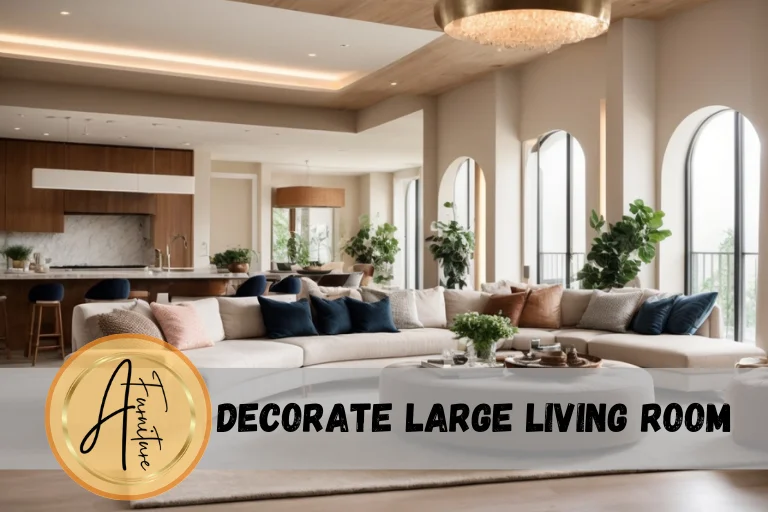
Challenges of Large Spaces

One of the biggest obstacles when dealing with a sizeable living room is knowing how to configure the layout. All that space can be daunting. Without strategic furnishing placement, the result may look sparse and unfinished. It can also lead to wasted areas that serve no real purpose. Furthermore, it’s easy for the seating to become too spread out, making conversation difficult. Acoustics may also suffer, with sounds echoing off the tall ceilings and bare walls.
Opportunities in Large Living Rooms
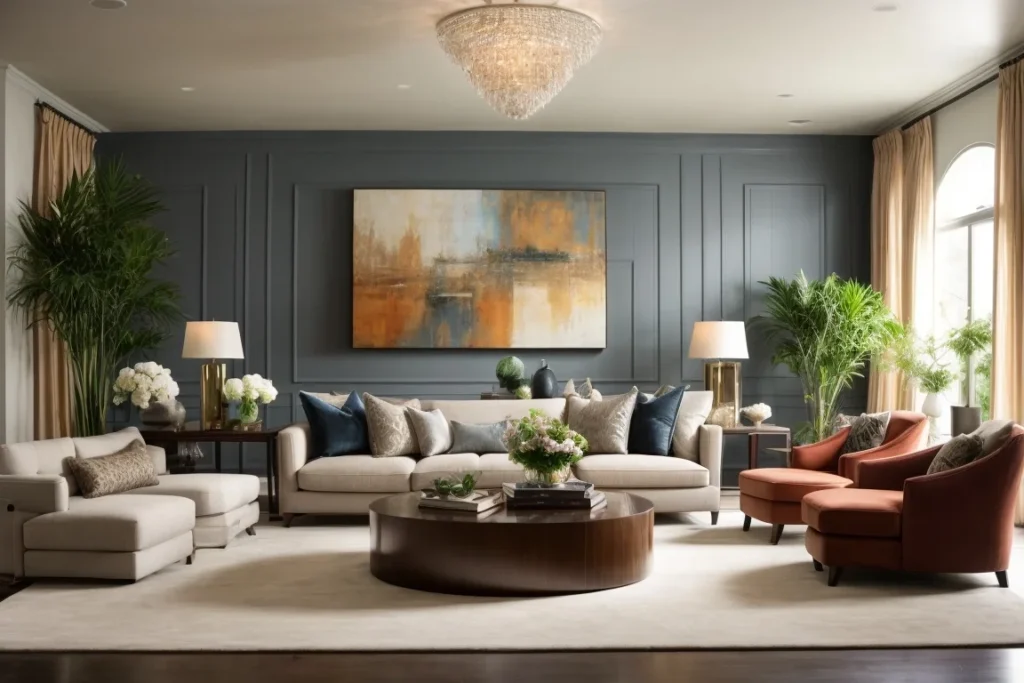
On the flip side, a spacious living room allows for flexibility in design. There’s plenty of room for multiple seating areas to accommodate large gatherings. You can create specialized zones for media, dining, games, etc. The expansive walls provide a great backdrop for displaying oversized artwork as a dramatic focal point. There’s also potential to delineate open-concept living spaces within the large volume using area rugs and intentional lighting. Overall, large living rooms provide a blank canvas for realizing an elegant, exquisite aesthetic.
Defining Spaces in a Large Living Room
One of the keys to making a cavernous living room feel warm and inviting is to break it up into well-defined spaces or zones. This gives the room intimacy and multipurpose functionality. Furniture, area rugs, and lighting are useful tools for delineating these spaces.
Zoning with Furniture
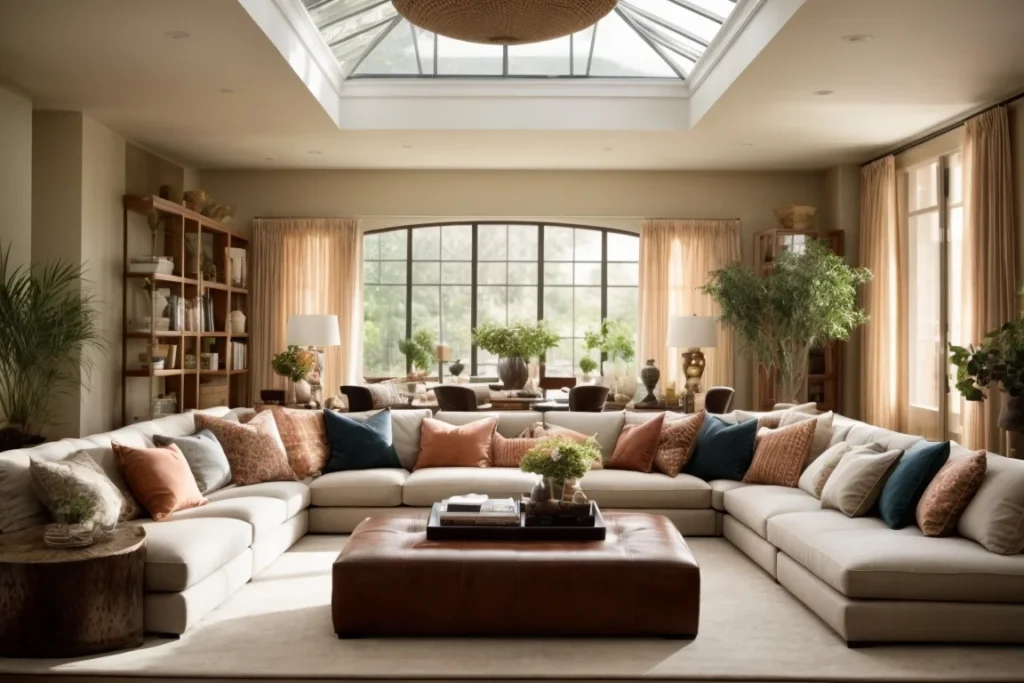
Placing furniture strategically helps carve out individual seating spaces or activity zones. For example, float a long sofa in the middle to divide the room into two conversation areas. Or place armchairs around a coffee table to form an intimate seating ensemble. Use bookcases or room dividers to separate a media zone from the main seating. The furniture groupings should create a sense of order while also facilitating natural circulation paths around the room.
Creating Intimacy in Large Spaces
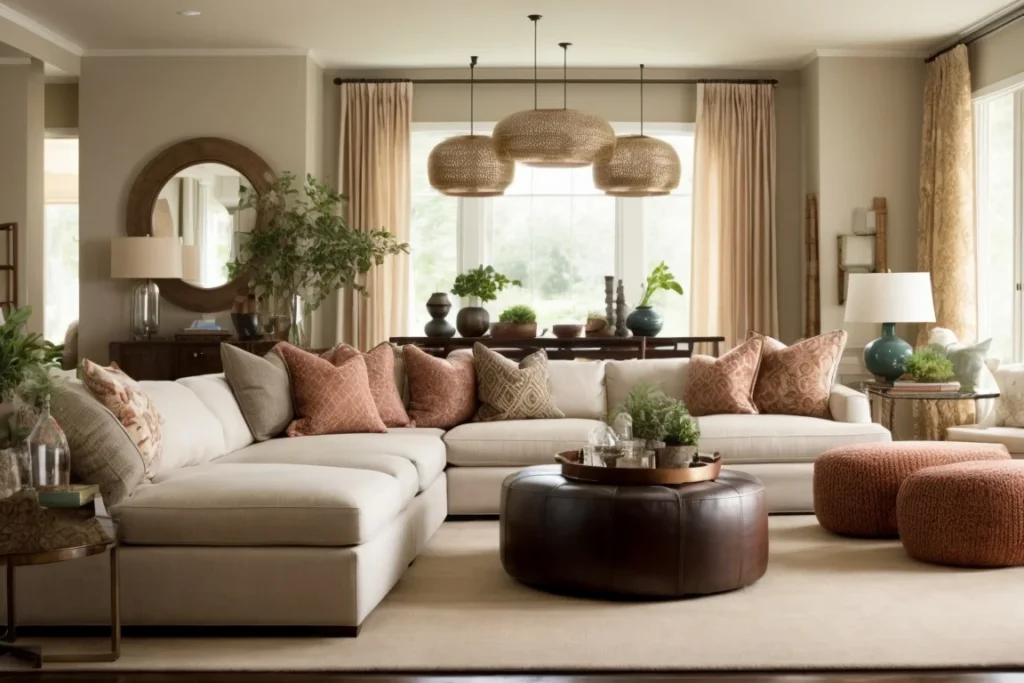
Although the living room is open, furniture groupings make each zone feel more intimate and well-contained. Place seating so people can converse without shouting across an empty void. Coffee tables, side tables, and ottomans give a tighter, clustered arrangement. Reduce echo and sound transfer between areas with thick rugs underneath furniture groupings. In general, furnish the room as you would several smaller, cozier living rooms.
The Role of Oversized Elements
When dealing with a sizeable living room, overscaled elements help fill the space in pleasing proportions. Big, bold furniture makes a statement while also providing ample seating. Massive artwork draws the eye and becomes a focal point. Oversized area rugs define zones in grand style. The eclectic mix of commanding large-scale pieces and smaller accessories creates visual balance throughout the cavernous space.
Visual Balance in Large Rooms
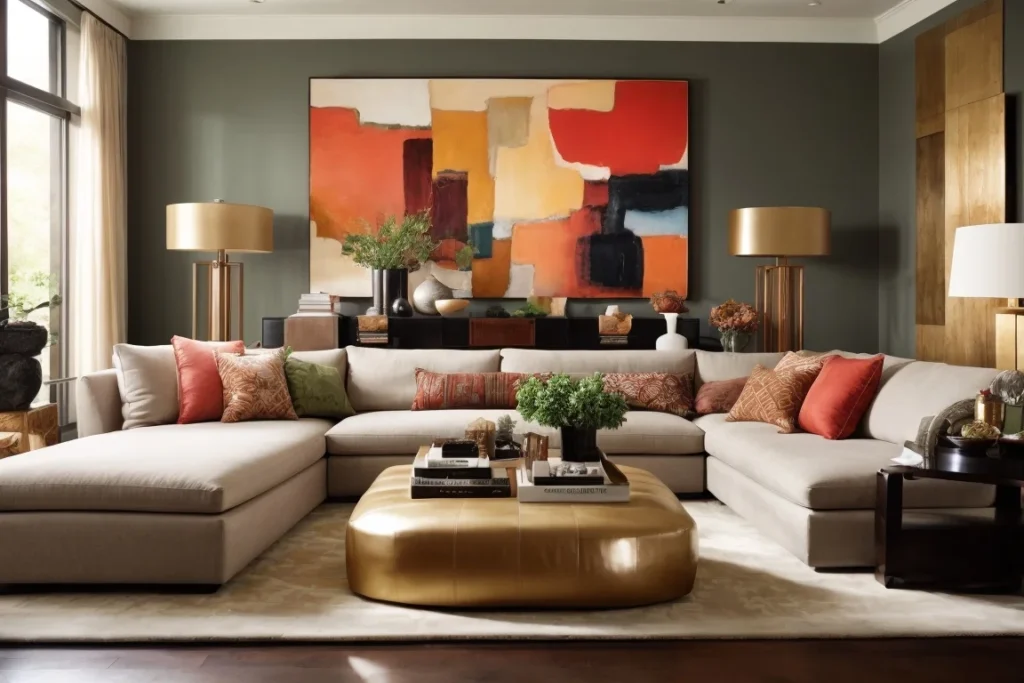
A common mistake is furnishing a large living room with pieces lost in the voluminous space. Instead, choose substantial, oversized items that hold their own. An oversized couch makes a luxurious centerpiece. A super-sized abstract painting provides artistic impact. The bold elements command attention with their presence, keeping the room from feeling sparse and incomplete.
Statement Pieces
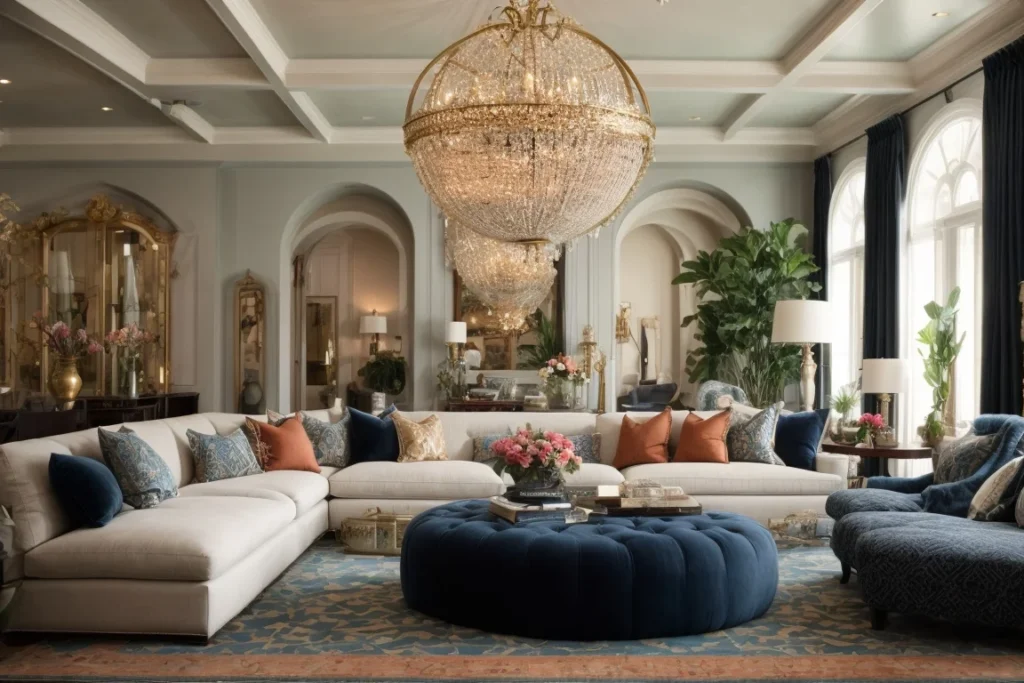
Every large living room needs anchor pieces that convey style while filling space. Look for furniture and accessories with heft and presence. An oversized chandelier makes a dramatic celestial statement. An expansive area rug defines a sitting area with color and pattern. The substantial furnishings will serve as inspired focal points while providing plenty of utility.
Textural Dynamics
Layering an array of textures together adds cozy appeal and visual interest to a spacious living room. Use textiles like velvet, leather, wool and linen in soft furnishings like pillows, throws and area rugs. Introduce natural materials like wood, marble, and stone into furniture and accessories. The combination results in a dynamic, multi-sensory experience.
Layering Textures
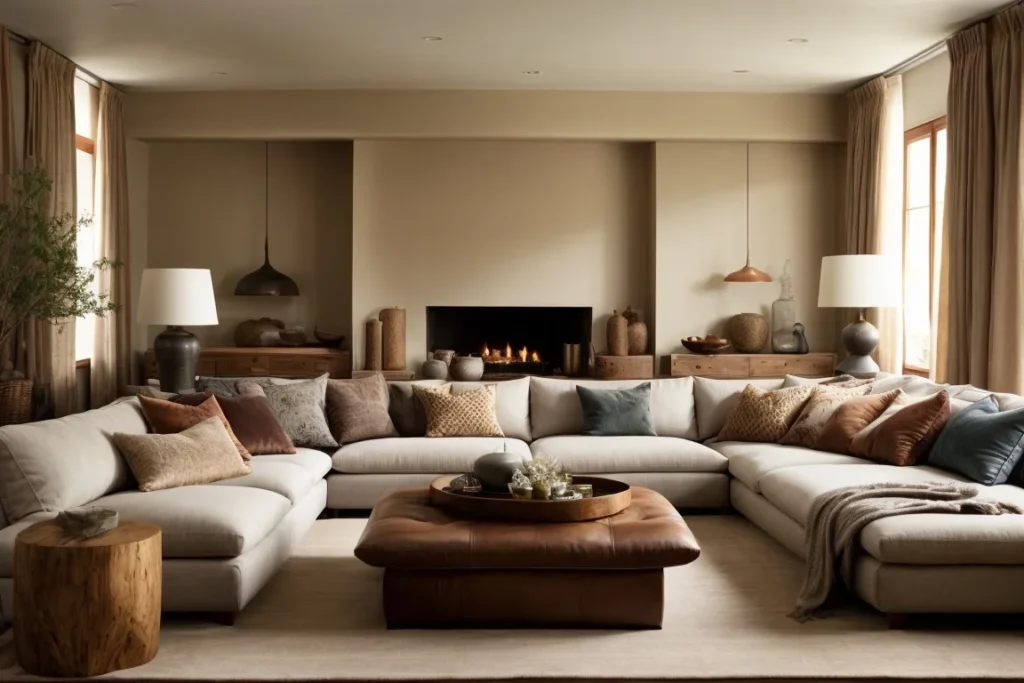
Creating depth through tactile layers is key for large living rooms. Sofas and chairs upholstered in velvet or leather provide a soft landing spot. A hand-knotted wool rug underfoot imparts comforting warmth. Throw pillows covered in nubby linen add another inviting texture. Wood coffee tables and shelving offer contrasting smoothness and grainy pattern. The more varied surfaces to see and touch, the more intimate the cavernous space feels.
Material Variety

Mixing the textiles and materials makes the living room achieve nuanced visual aesthetics. For instance, juxtapose sleek marble-topped side tables with a reclaimed wood media console. Combine a velvet sofa, linen armchair, and leather ottoman. The eclectic blend of tactile surfaces creates a multi-layered, high-end look while adding cozy appeal.
Color and Lighting
Paint colors and lighting choices greatly impact the ambiance of a living room. Warm hues and varied light sources help make a large living room feel enveloping and inviting. These elements also influence the perceived dimensions of the interior.
Ambient Lighting
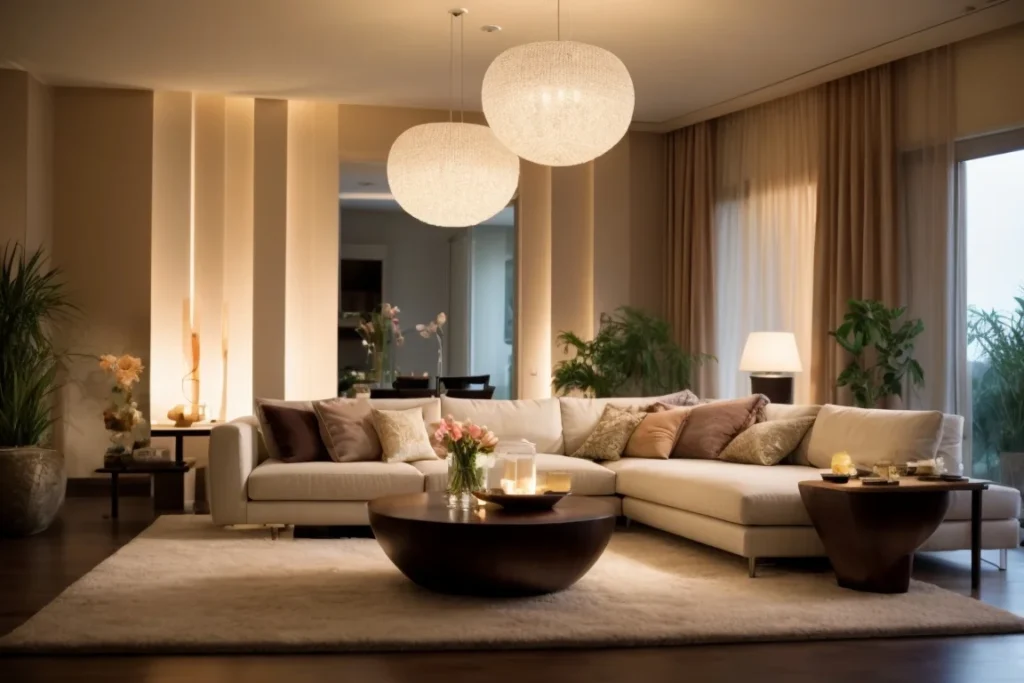
Rather than brightly illuminating the entire living room, use ambient lighting to create a soft glow. Table and floor lamps generate pools of light around seating areas for an intimate feel. Dimmer switches allow modifying the strength of overhead fixtures. Uplights placed strategically wash the walls with a gentle luminosity. The result is a calm, welcoming environment.
Color Psychology
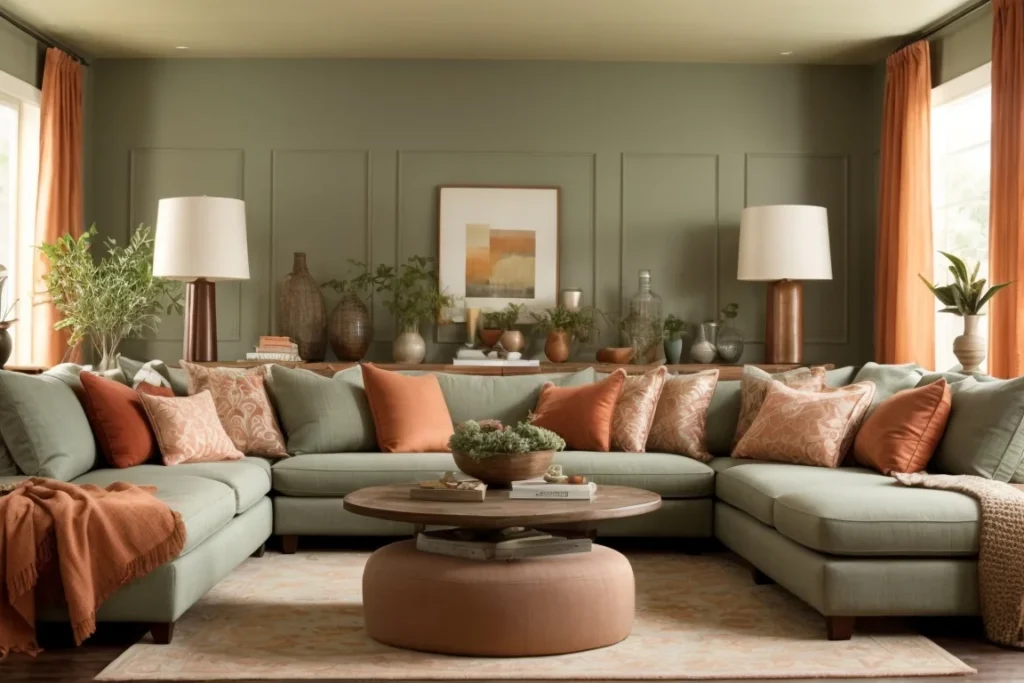
Cool paint colors tend to visually expand space, which is counterproductive in a sizeable living room. Instead, opt for warm hues like tan, terracotta, peach or sage green. The cozy colors make the walls feel less far away. Deeper shades can be used for accent walls or on built-in cabinetry for grounded contrast. Avoid stark whites, which tend to exacerbate the cold, hollow feeling.
Furniture Arrangement
Strategic furniture placement is critical in a large living room. Avoid walling off seating areas or pushing all the furniture to the perimeter. Instead, strike a balance between floating central furnishings and anchoring pieces against the walls. This creates an inviting layout with logical flow.
Spatial Planning
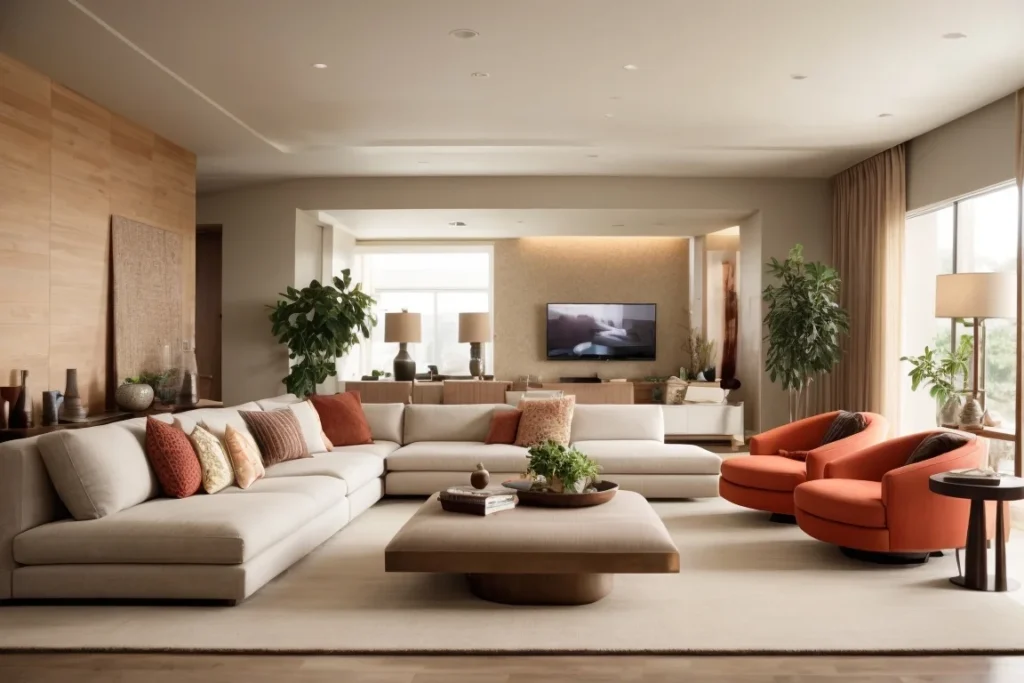
Start by mapping out activity zones, leaving ample space around and between. Position any TVs or media components along a natural focal wall without dominating. Place modular seating to facilitate conversation and traffic flow. Angle furniture to create visual interest and diagonal sightlines. Floating rugs help contain the groupings while allowing continued movement. The thoughtful layout maximizes open circulation while still feeling welcoming.
Furniture Layout

Unless used to divide zones, avoid lining up furnishings flat against the walls, which looks sparse and closed off. Instead, pull armchairs and sofas away from the perimeter to promote flow. Balance centrally placed seating with consoles, bookshelves or cabinets against the walls for stability. Vary the orientation and height for dynamic diversity. The mix of anchored and airy furniture promotes both order and flexibility.
Greenery and Natural Elements
Incorporating indoor plants, fresh flowers, and other organic materials makes a large living room feel comfortably livable and inviting. Greenery helps soften hard edges and improves air quality. Natural accessories impart warmth and serenity through biophilic design principles.
Biophilic Designs inherently feel soothed and rejuvenated by exposure to the natural world. Bring those benefits inside through biophilic design. Strategically placed plants foster psychological peacefulness and overall wellbeing. Botanical artwork and photography also strengthen the connection with nature. Natural materials like stone, wood and rattan in decor also lend an earthy, organic vibe.
Indoor Plants

Plants are a classic way to inject living color and freshness. Place tall leafy varieties in floor pots for vertical interest. Set smaller succulents and herbs atop console tables. Create a living wall display or built-in planter for greenery impact. Not only lovely to look at, the plants improve air quality by reducing toxins. Their presence imparts tranquility and calm.
Architectural Details
Incorporating architectural elements like beams, built-ins, moldings and ceiling details gives a spacious living room appealing character. These permanent accents complement the furnishings by lending visual interest, texture and charm. They help establish the interior architecture needed in a sizeable volume.
Architectural Accents
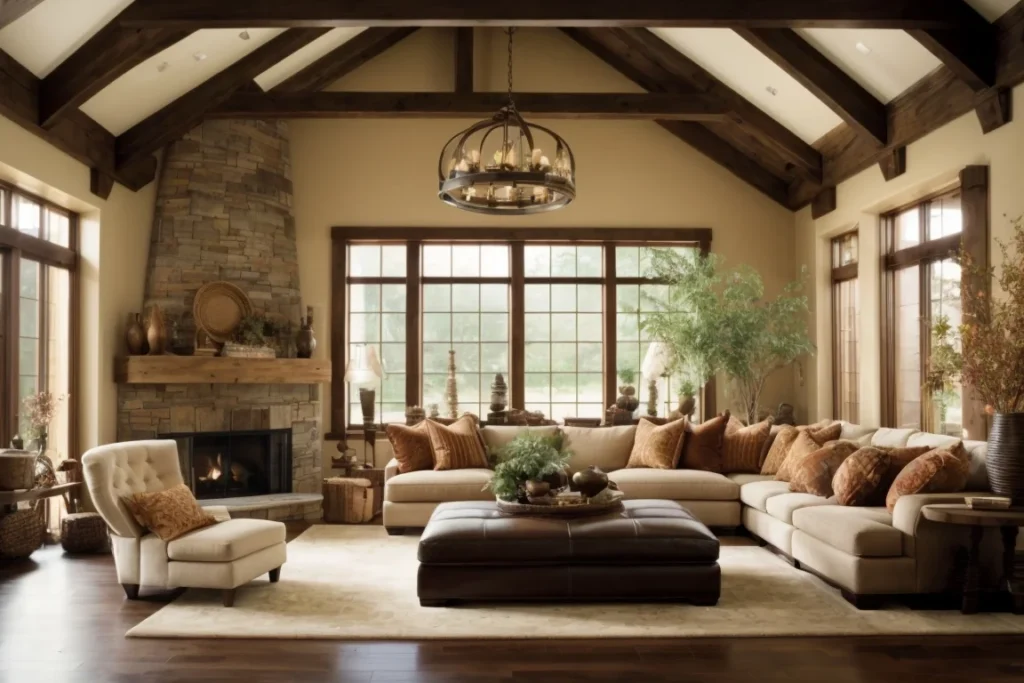
Find ways to add permanent architectural interest to balance the grand living room proportions. Exposed wood ceiling beams add rustic, textural allure. Picture rail molding allows flexible artwork display. Built-in window benches soften expansive walls with cozy seating. A floor-to-ceiling stone fireplace makes a striking focal point.
Built-in Solutions
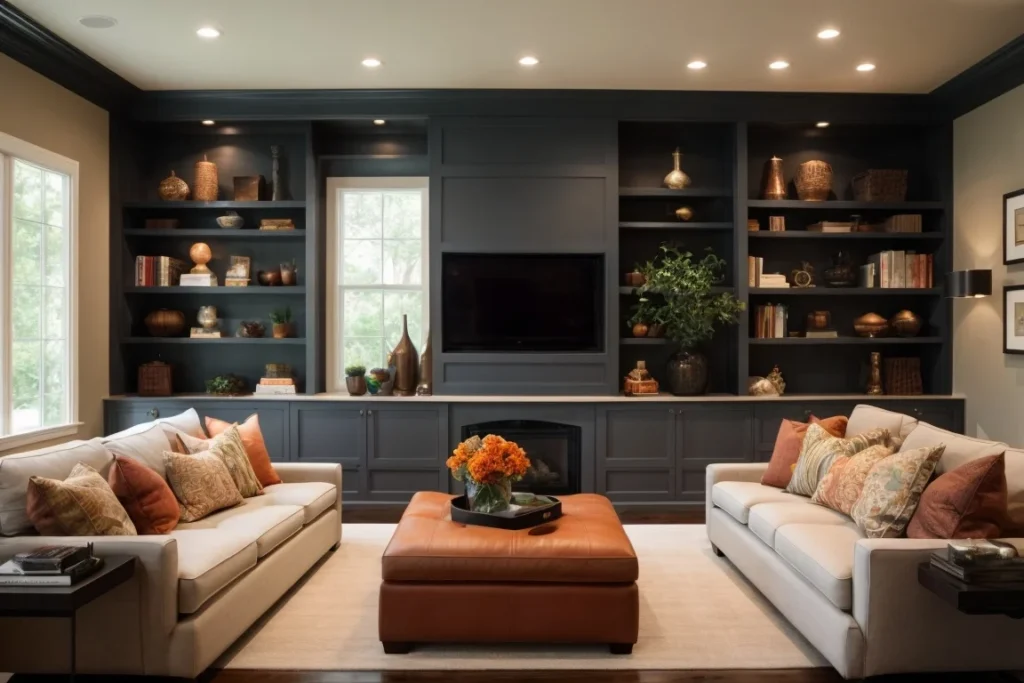
Built-ins like bookshelves, cabinetry, and window seating provide valuable storage and functionality. Recessed shelving flanking the fireplace organizes media components. A window bay with storage benches is both charming and practical. Built-in cabinets painted a dramatic color become part of the interior architecture. The customized elements cater specifically to your needs while elevating the aesthetic.
Flooring and Proportions
With abundant space to cover, flooring choices significantly impact the living room aesthetic. Hard materials like stone and hardwood can feel cold and echoey. Using area rugs helps soften the flooring while defining functional spaces. Getting the proportions right is also key to comfort.
Floor Treatments

Solid hardwood or stone tiles make a handsome base for a large living room floor. But wall-to-wall hard materials can feel imposing. Layer in some coziness and sound absorption with area rugs. Place substantial rugs under each seating ensemble to designate individual spaces. Make sure they’re large enough to contain all legs of the furniture grouping. Rugs with texture add comfort underfoot as well.
Scale and Proportion
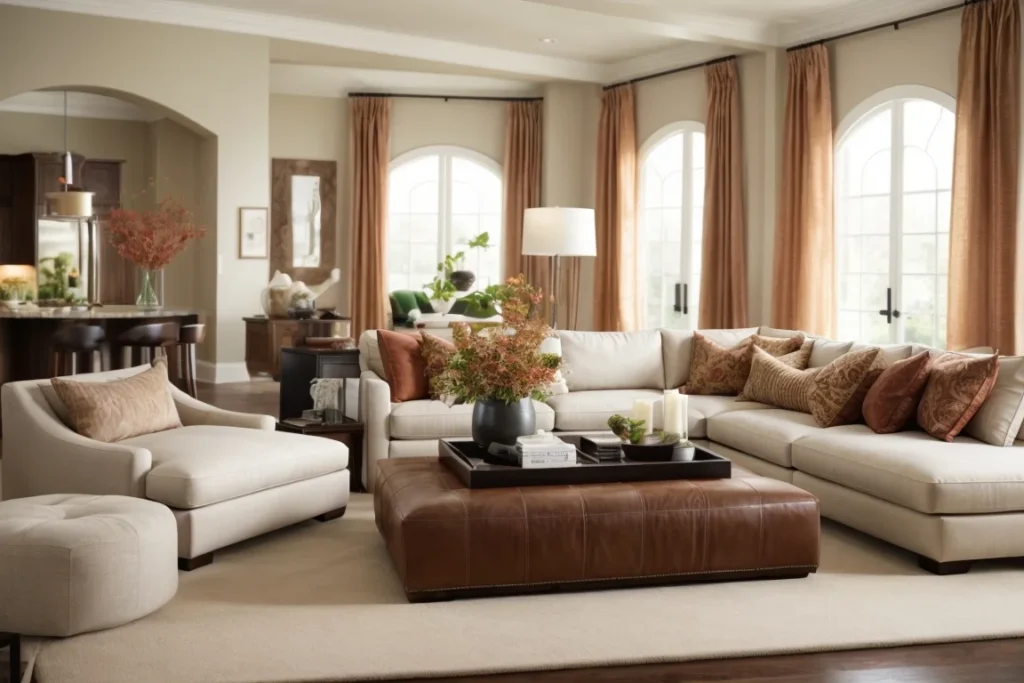
When furnishing a sizeable living room, proportion is key for functionality and comfort. Ensure coffee and side tables are appropriately scaled to complement sofas and chairs. finding the right rug dimensions to fit the space is also important. Oversized furniture with clean lines helps fill the volume correctly. Arrange seating at conversing distances rather than overly spread out. The thoughtful scaling promotes overall comfort.
Lighting Layers
Proper illumination makes a cavernous living room feel welcoming in the evening. Create a cohesive lighting plan using a variety of fixture types at different heights. Mix ambient, task, and accent lighting for a well-lit, multi-dimensional room.
Layered Lighting
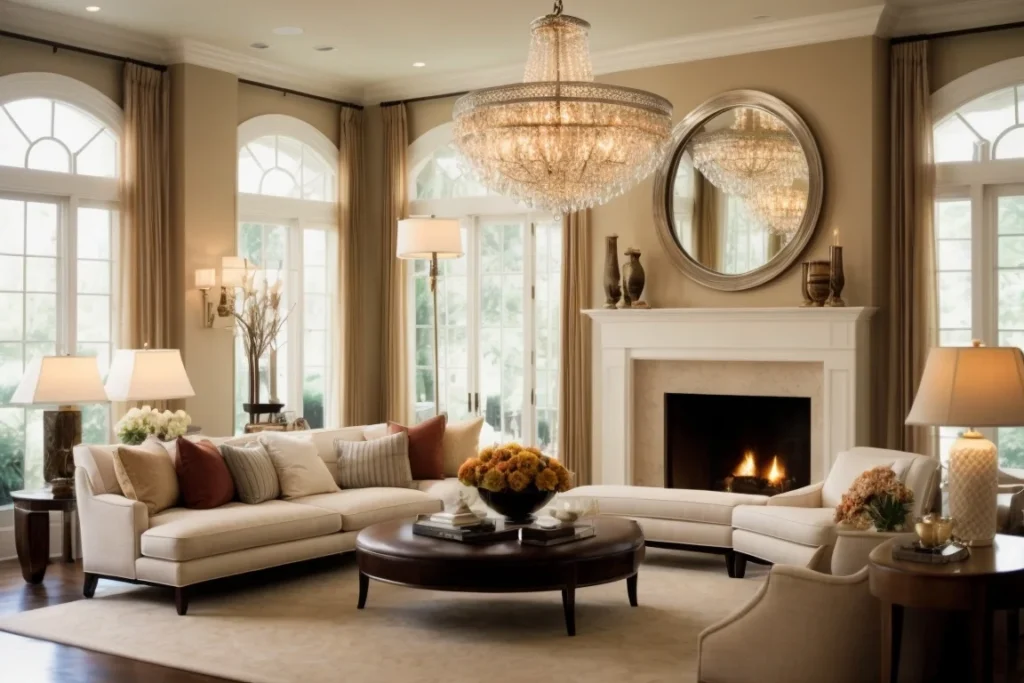
A common mistake is relying solely on an overhead chandelier to light a substantial living room. While a large statement chandelier does provide drama, it needs supplementation. Add table lamps for illumination beside seating areas. Use floor lamps for accent and task lighting. Install sconces to spotlight artwork and architectural details. The combined layers ensure the expansive space is comfortably bright.
Lighting Types

Overhead chandeliers and pendants provide ambient glow from above. Table and floor lamps generate more intimate pool of light. Recessed cans supply overall illumination along with task lighting as needed. Wall sconces shine accent lighting on displays and surfaces. Mixing up the fixture styles and placements gives you stylish lighting design and ideal visibility.
How to Design an Interior for a Large Living Room
Designing the interior of a spacious living room requires thoughtful planning and strategic furniture arrangement. Large, open floor plans provide abundant possibilities but also pose design challenges. Dividing the expansive space into sensible zones creates a logical layout. Tailoring furniture scale and proportions prevents a hollow feel. Incorporating ample lighting and comfortable acoustics transforms the voluminous room into a welcoming oasis for relaxation and entertaining.
Define Activity Areas with Floor Plan Principles
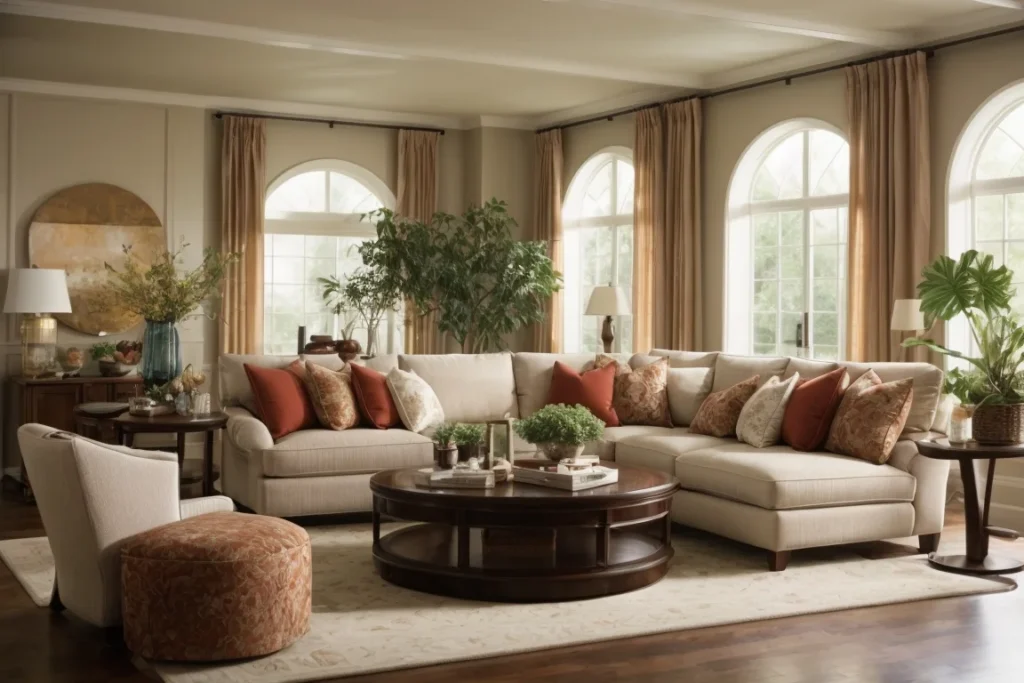
The first step in designing a sizeable living room is mapping functional activity zones. Carefully planning the layout establishes optimal flow and circulation. Arrange the furniture groupings based on how the space will be used regularly. Often a large living room accommodates both intimate seating arrangements and room for mingling.
Some key principles for floor planning an oversized living room include:
- Floating furniture away from walls prevents a cramped appearance and allows movement throughout the space. Place sofas, chairs and tables at least 18-24 inches from the perimeter.
- Incorporating multiple seating zones – Include a few conversation areas for both small and large groups. Angle the arrangements to promote interaction.
- Allowing ample circulation space – At least 3-4 feet around and between furniture groupings prevents bottlenecking when navigating the room.
- Defining spaces with area rugs – Rugs delineate zones visually and acoustically without compromising openness.
- Considering conversation clusters – Float chairs opposite sofas and angle seating inward to facilitate dialogue.
Thinking through the living room layout by zones results in sensible form and function. Once the furniture footprints are mapped out, the activity areas naturally emerge.
Use Anchors and Ceiling Details for Architectural Interest

Large living rooms often feature high, airy ceilings. While this lends a spacious quality, it can also feel echoey or cavernous without proper interior architecture details. Add visual anchors throughout the room to define the volume. If possible, incorporate varied ceiling heights, beams or soffits to delineate seating arrangements.
Some options for adding structural details include:
- Floating a statement light fixture as a focal point – A striking chandelier or linear pendant visually defines the space while adding ambient lighting.
- Incorporating architectural beams or panels breaks up the expanse horizontally and establishes ceiling height variations.
- Adding thick trim molding around the perimeter – Picture frame molding defines the architecture and brings the eye downward.
- Floating shelving or cabinetry along walls provides both storage and visual framework.
- Utilizing an accent wall or focal fireplace – These architectural elements ground the space and provide a visual anchor.
The structural details lend visual rhythm while enhancing the grandeur of the living room’s generous proportions. When defining the architecture, adhere to proper scale and allow the details to harmonize with the room’s volume.
Incorporate Ample, Multi-Layered Lighting
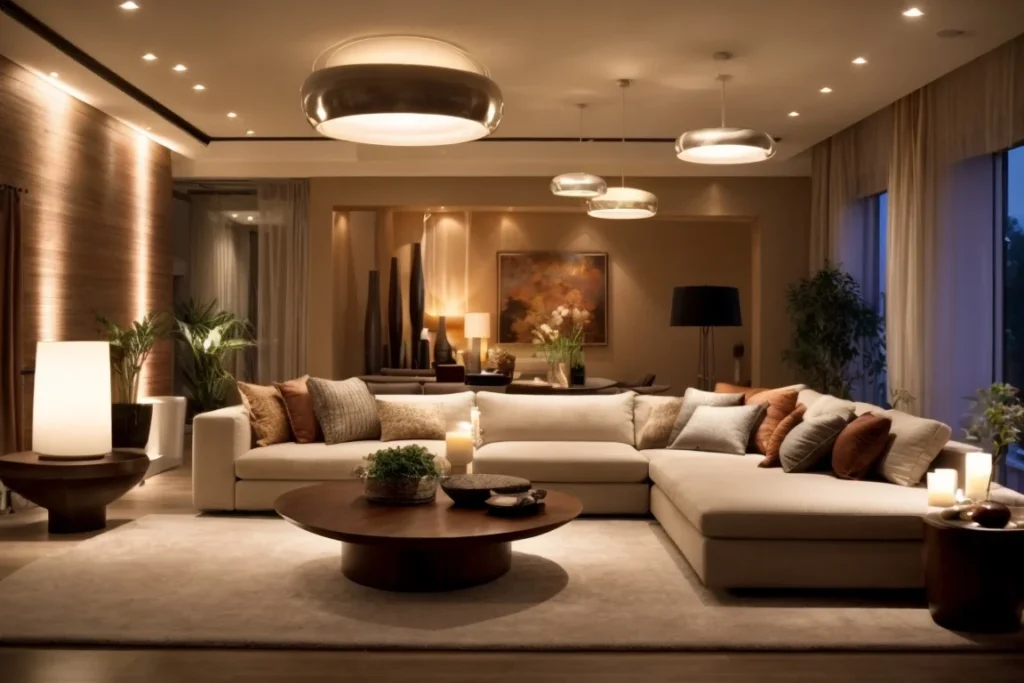
Incorporate ample lighting layers for large living room illumination to warm and inviting the expansive space. Combining overhead ambient lighting with portable lamps prevents a dark, cavernous feeling.
Some tips for lighting a sizeable living room include:
- Installing recessed cans overhead – These provide bright ambient light for general illumination. Space evenly to avoid a spotty appearance.
- Floating statement chandeliers or pendant lamps – Dramatic fixtures define seating arrangements with an artistic element.
- Mounting sconces alongside furniture – Wall lamps illuminate seating areas with a decorative accent.
- Using floor and table lamps – Portable fixtures make the lighting design flexible and add cozy ambience.
- Adding discreet LED strip lighting – Hidden strips along shelves or under seating provide a soft glow.
- Dimming overhead and accent lighting – This allows adjusting the mood for daytime and nighttime use.
The living room maintains a warm, welcoming vibe free of harsh shadows or dark voids with abundant, multi-point illumination. The layered lighting flatters both architectural details and furnishings.
Choose Ergonomic, Acoustically Absorptive Furniture

Furnishing a sizable living room requires choosing ergonomic pieces for cozy lounging and conversation. Overstuffed cushions and absorbent textiles prevent echoes for comfortable acoustics. Whether designing a formal parlour or relaxed family room, ensure the seating promotes both proper posture and sound dampening.
Some ergonomic, acoustical furniture options include:
- Overstuffed sofas and armchairs – Plush cushions and pillows absorb sound vibrations and feel ultra-soft. Curved rolled arms provide ergonomic support.
- High-back sofas and chaises support the spine for comfortable lounging and hushed sound. Avoid low-back seating which feels sparse and echoes more.
- Tufted and slipcovered pieces – Tufting adds tactile, acoustical interest while slipcovers feel casual yet absorbent.
- Sectionals with moveable ottomans – The varied configurations and loose cushions promote sound absorption and lounge-worthy softness.
- Covered side chairs and benches – Upholstered dining seating muffles sound during conversation and casual entertaining.
The living room feels serene and comfortable with substantial, thickly padded furniture. Prioritize pieces that support the body naturally and prevent sound reverberations.
Adhere to Scale and Proportion Guidelines
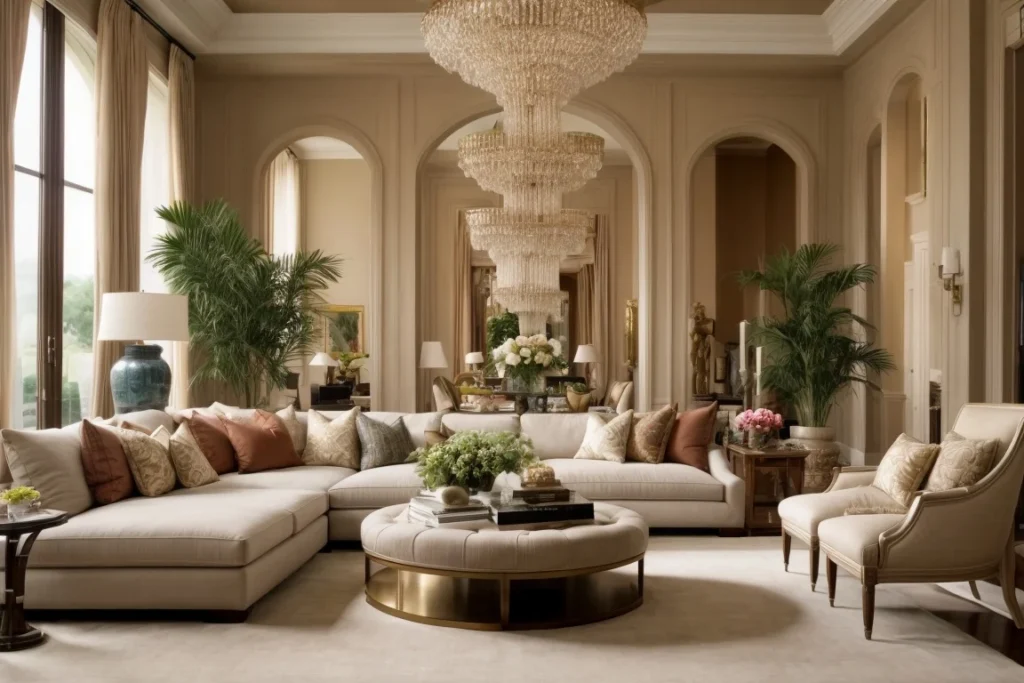
When furnishing an oversized living room, adhere to interior design guidelines for expansive spaces. Oversized rooms require equally substantial furnishings for proper scale and balance. Yet pieces that feel too minuscule leave the interior sparse and echoes prone. Carefully select furnishings that harmonize with the grand architecture.
Some general scale and proportion tips include:
- Choosing substantial coffee tables – Look for sturdy rectangular tables around 50-60 inches wide and 28-32 inches high.
- Incorporating expansive area rugs – Rugs should extend 18-24 inches beyond furniture grouping perimeters to define the zones.
- Floating ample side chairs – Look for seats at least 36 inches wide and arms 24 inches high for proper proportions.
- Utilizing oversized art – Massive canvas pieces make a dramatic style statement befitting the room.
- Adding heavyweight drapery panels – Hung near the ceiling, voluminous drapes accentuate tall windows.
- Repeating consistent cushion sizes – Keep toss pillows around 22 inches square for harmonious scale.
The thoughtful scale and proportion of furnishings helps balance the generous living room volume. Oversized pieces feel cohesive yet inviting.
How to Arrange a Spacious Living Room
Arranging abundant seating options and defining activity zones is key to making a large living room layout feel organized and inviting. Avoid simply lining furniture against the walls, which looks sparse. Instead, create dynamic vignettes that promote conversation and connection. Layer rugs beneath to define the spaces while allowing open circulation. The careful furniture arrangement transforms space into welcoming lounging areas.
Map Out Conversation Areas and Pathways
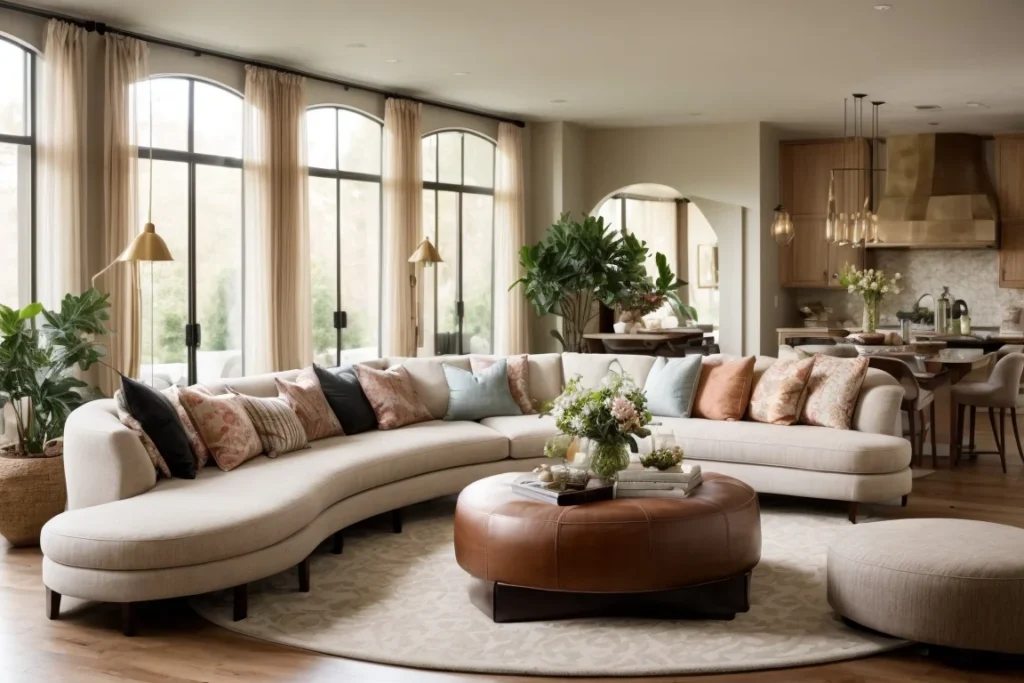
The first step in arranging an expansive living room is mapping out conversation areas and pathways between them. This provides a sensible floorplan tailored to how the space functions. Allow at least three feet around and between furniture groupings for easy circulation. Angle the furniture arrangements inward to promote intimacy and interaction.
Some tips for mapping conversation zones include:
- Floating sofas away from walls to anchor arrangements
- Facing armchairs toward sofas across coffee tables
- Layering side chairs and ottomans around larger pieces
- Allowing enough clearance for entryways and traffic flow
- Leaving space for temporary furniture like fold out tables
Planning seating clusters and convivial pathways prevents a haphazard appearance and awkward bottlenecks. The living room remains serenely spacious yet organized.
Incorporate Substantial Furniture Proportions
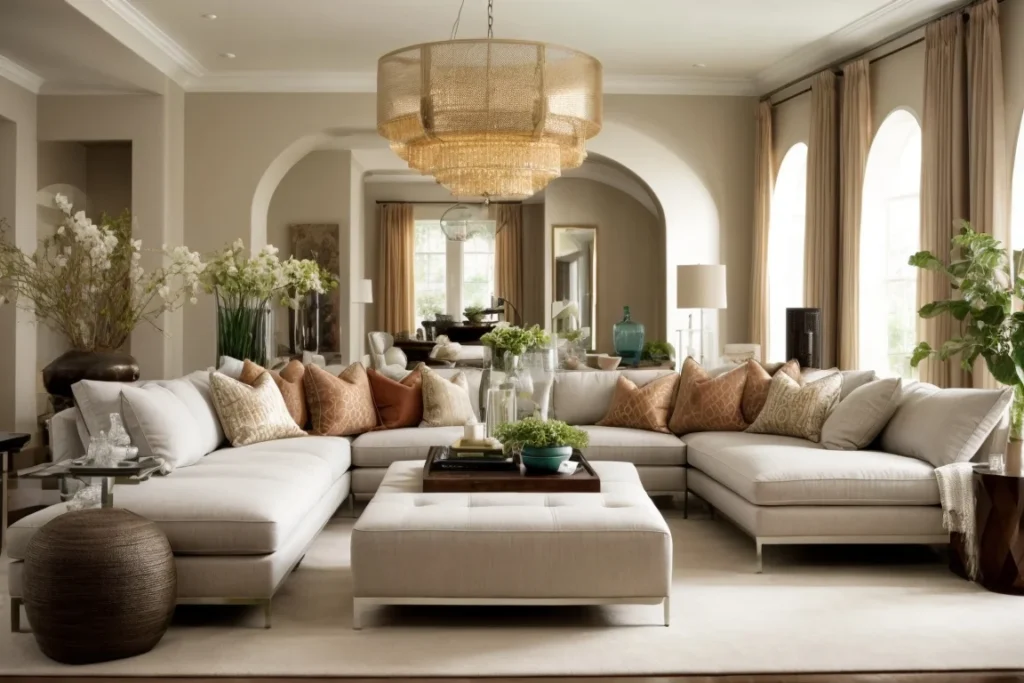
Furnishings with ample mass and presence fill living room volume appropriately. Overscale the core pieces like sectionals, sofas and benches. Yet balance with lighter complements like acrylic and streamlined metal accents. The mix of substantial and airy keeps the interior feeling spacious rather than crammed.
Some appropriately scaled furnishings include:
- Deep sectionals at least 104 inches wide
- Oversize square ottomans around 36 to 48 inches wide
- Armless parsons chairs that tuck beneath tables
- Elegant bench seating at the room’s perimeter
- Rectangular coffee tables, nested in pairs if needed
The hefty furniture forms the foundation around which other furnishings layer seamlessly. Sturdy bases and expansive profiles suit the setting best.
Use Rugs to Define Spaces

Area rugs provide a clever tool for delineating living room zones and activity hubs without compromising openness. Use substantial sizing, at least eight feet wide for seating areas. Neutral palettes keep the interior serene and spacious. Weave natural fibers like wool and jute to add organic texture.
Some area rug tips include:
- Extending at least 18 inches past furniture edges
- Floating organically rather than lining up squarely
- Repeating a consistent palette to tie zones together
- Pairing soft pile rugs with sleek furniture profiles
Create Sightlines Between Arrangements

A common challenge in spacious living rooms is creating cohesive flow from one conversation area to another. Clever furniture angles prevent disconnected vignettes. Aim for ample open sightlines so seating groups feel united yet private simultaneously.
Some tips for crafting captivating sightlines include:
- Angling sofa backs diagonally across the room
- Floating circular chairs around rectangular tables
- Alternating high and low seating heights
- Allowing views through transparent furniture pieces
- Repeating design elements like pendant lamps in sightlines
The dynamic lines of vision make the living room layout intriguing yet harmonious. Guests feel connected to the entire space regardless of seating choice.
Add Sculptural Lighting and Organic Texture
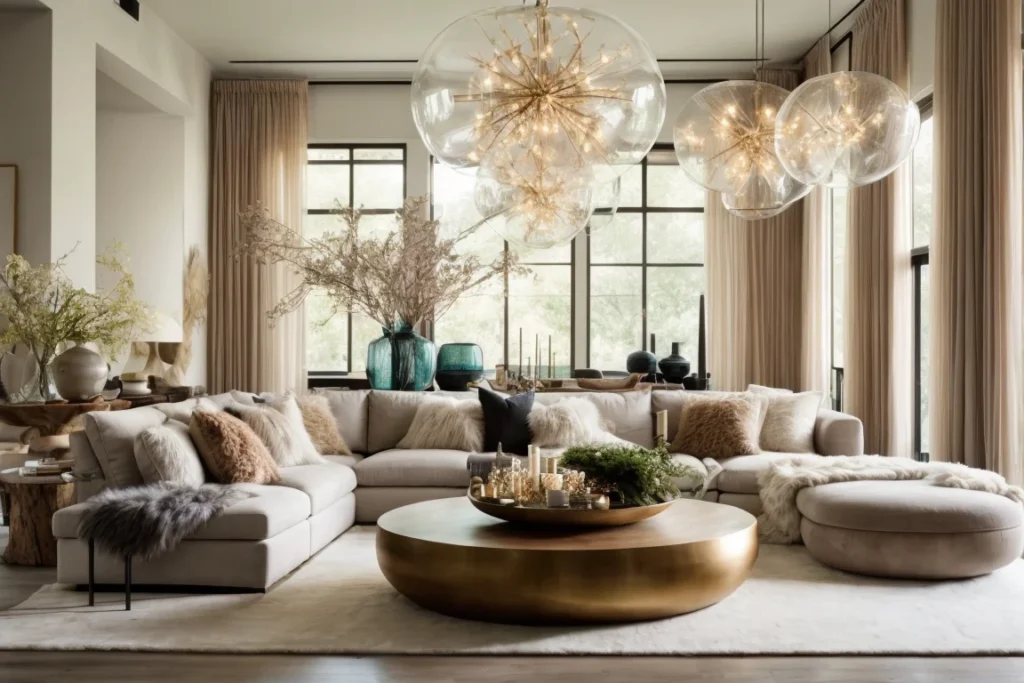
Incorporate sculptural lighting fixtures and organic accents to prevent a vacant appearance. Visually lightweight pieces like abstract chandeliers and fresh florals add comfort without clutter.
Some options for infusing organic texture include:
- Suspending modern bubble or branch chandeliers overhead
- Floating glass orb table lamps with linen shades
- Displaying tall vase arrangements on console tables
- Layering sheepskin and cowhide throws on seating
- Adding wood and rattan accents in neutral tones
The natural shapes and textures inject cozy allure into the voluminous interior. Each tactile detail adds interest without interrupting graceful flow between zones.
Modern Large Living Room Ideas
A minimalist approach allows the grand proportions to shine for a contemporary, design-savvy look in a spacious living room. Sleek, refined furnishings and a neutral color scheme emanate understated elegance. Pops of vibrant accessories and organic accents provide modern contrast. The pared-down aesthetic celebrates both architectural grandeur and chic restraint.
Choose a Sleek, Monochromatic Palette
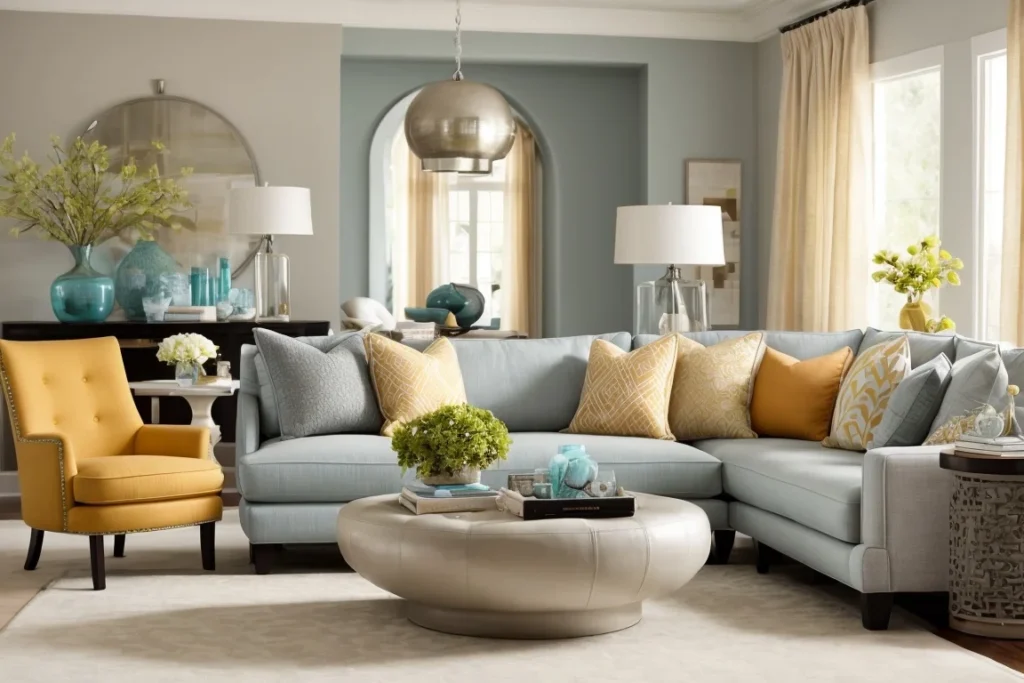
A limited color scheme provides a serene, stylish backdrop tailored to generous dimensions. Stick to a simple triad such as black, white and gray. Accent occasional chairs or pillows in a bold citrus or azure blue pop. The neutral canvas keeps the interior tranquil and timeless while bright notes add liveliness.
Some tips for executing a crisp, modern color palette include:
- Selecting soft gray sectionals or sofas as a foundational neutral
- Repeating black accents through lighting fixtures and occasional tables
- Adding white framed artwork for graphic punch against dark walls
- Floating turquoise or chartreuse armchairs as vibrant accents
The predominantly minimalist scheme feels infinitely spacious. Pops of color serve as focal points amid the understated chic.
Choose Modern Sculptural Shapes
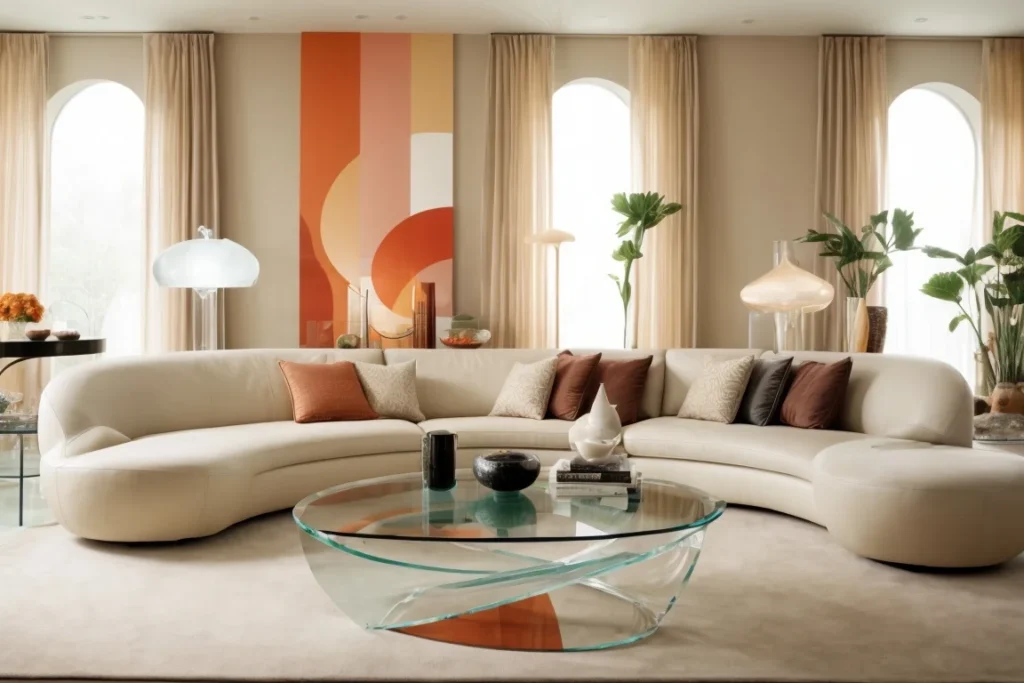
Abstract, sculptural furnishings make a statement within ample negative space. Look for contoured seating, oval coffee tables and curved floor lamps. Acrylic and glass tabletops add transparent lightness. The contemporary profiles harmonize with clean lines and high ceilings.
Some modern sculptural pieces include:
- Curved sectionals with rounded corners
- Oval or amoeba-shaped cocktail tables
- Orb and cone-shaped pendant lighting
- Contoured lounge chairs with cut-out silhouettes
- Acrylic dining chairs with see-through style
The shapely furnishings feel artistically avant-garde. Their profiles make them ideal anchors for modern living room arrangements and groupings.
Add Pops of Texture with Plants and Art

Prevent a stark minimalist interior by incorporating tactile accents. Abstract art introduces colorful texture and shapes. Fresh flowers and potted plants infuse organic allure. Macrame wall hangings or wood shelving offer touchable contrast. The layers add cozy appeal within the sleek interior.
Some ways to incorporate modern texture include:
- Hanging bold abstract paintings as focal points
- Displaying overflowing potted ferns on stands
- Floating woven pendant lamps over seating zones
- Layering nubby linen and sheepskin throws
- Floating a macrame tapestry on the wall as artwork
Each tactile addition complements the elegant aesthetic while reflecting contemporary living. The textural layers keep the modern interior inviting.
Large Living Room Layout With TV
When incorporating a television into a spacious living room, strategic furniture arrangement prevents any awkward layouts. Avoid simply floating the TV above a fireplace or on a distant wall. This disrupts sightlines and strains viewing. Instead, create a comfortable, contemporary media zone that flatters the living room’s generous dimensions.
Avoid Dominating Focal Points
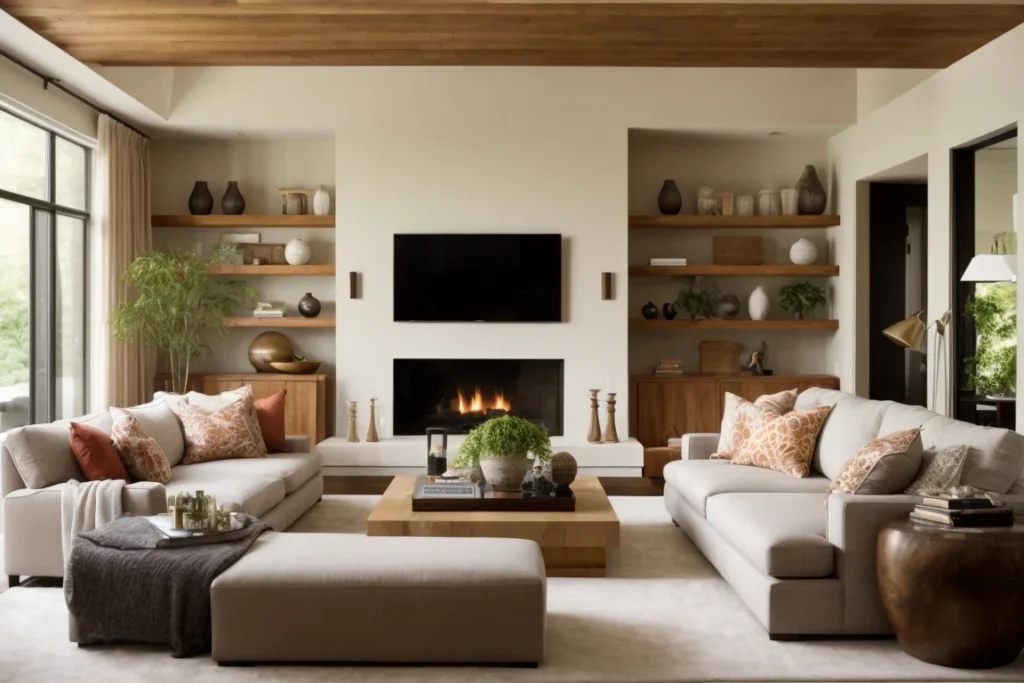
Mounting a large television above a statement fireplace or piece of artwork generally detracts from the existing focal point. The competing elements feel disruptive and distracting. Instead, look for a less prominent wall without major design features. Position the TV to one side rather than centrally over a focal feature for balance.
Some tips for positioning include:
- Installing the television on a plain, unadorned wall.
- Tucking it inside an architectural niche or alcove.
- Floating it beside a linear fireplace or non-dominant art piece.
- Mounting it on a side wall out of main sightlines.
Keeping the television position clean and simple prevents it from hijacking attention. The understated placement suits the proportions better.
Create a Defined Media Zone
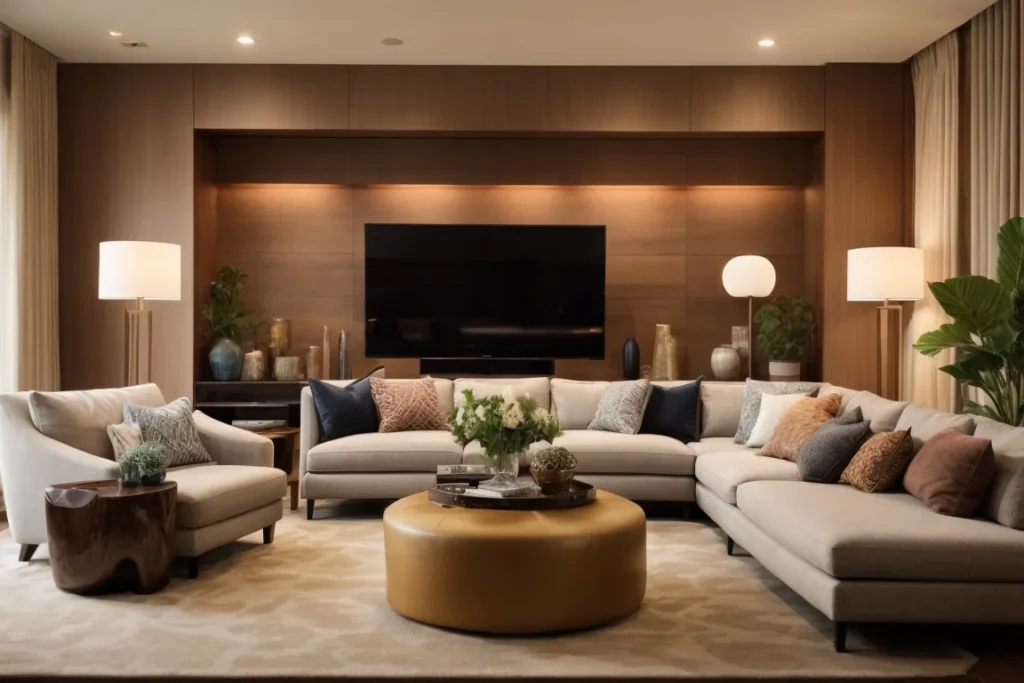
Rather than just floating a television aimlessly, design a purposeful, positioned media viewing area. Include comfy seating aimed at the screen and layered lighting. Use an area rug to define the footprint. The tailored vignette prevents a disruptive, randomly placed effect.
Some ways to define the TV zone include:
- Facing armchairs and a sleek media console toward the screen
- Floating floor and table lamps beside seating for illumination
- Layering side tables and poufs for convenience and flexibility
- Extending a patterned area rug beneath the arrangement
The deliberate furniture layout makes media viewing relaxing and enjoyable for large and small gatherings.
Add Ambient Lighting to Prevent a Dark Room Effect
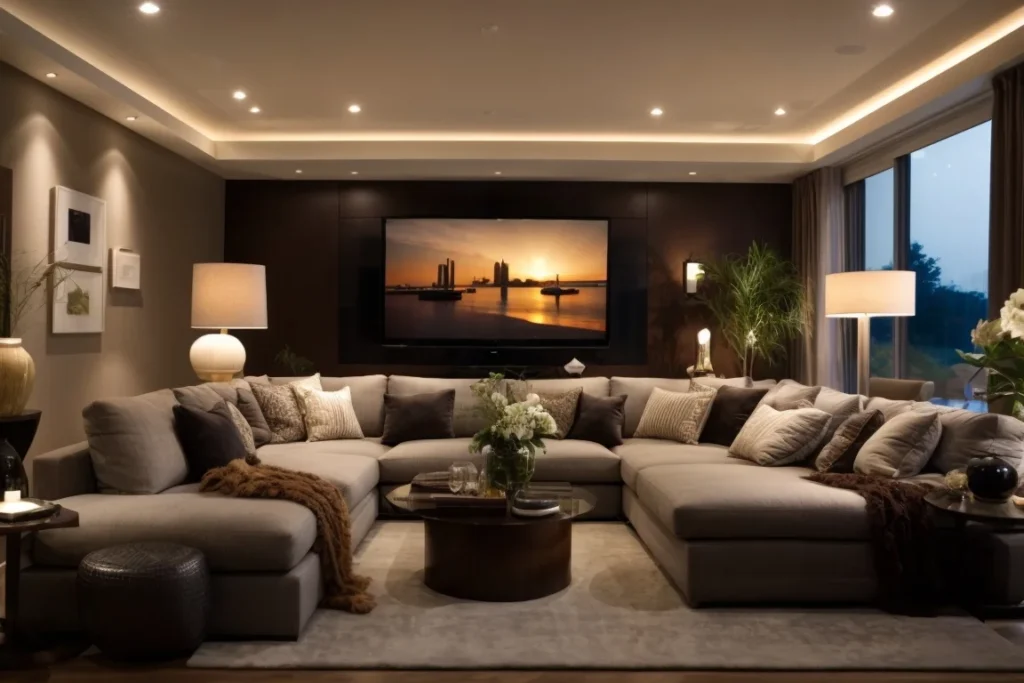
A common pitfall of living room TV layouts is bright screens paired with dim surrounding light. This creates a dark, cinema vibe rather than bright, welcoming space. Counteract with abundant ambient lighting. Use floor lamps, sconces and pendant fixtures to illuminate the space.
Some ways to add ambient lighting include:
- Hanging pendant lamps above or beside seating zones
- Flanking the television area with table lamps
- Attaching adjustable swing arm sconces behind chairs
- Incorporating discreet LED strip lighting along shelves
The living room maintains brightness and visual comfort for television viewing and conversation with a well-lit backdrop. The strategic lighting keeps the interior inviting.
How to Divide a Large Living Room
Incorporate architectural details and furniture arrangements to create sensible zones for better organization in an oversized living room. The divisions separate seating nooks and activity areas while maintaining an open, airy layout. Strategic definition lends both function and visual interest.
Use Ceiling Beams or Shelving as Room Dividers

Incorporate structural room dividers like ceiling beams, shelves or bookcases sparingly to delineate seating groups and activity hubs. The vertical elements break up the room horizontally without compartmentalizing. Maintain at least three feet between dividers for open flow. Match the finish and style to the interior decor.
Some room divider ideas include:
- Floating open wood or glass bookcases to separate seating
- Suspending linear pendant lamps from beam to beam
- Extending thick ceiling beams perpendicular to open shelving
- Repeating built-in cabinetry modules across large walls
The structural dividers lend organization while accentuating architecture and allowing flexibility. Contents can change while forms remain constant.
Use Coordinating Area Rugs to Define Spaces
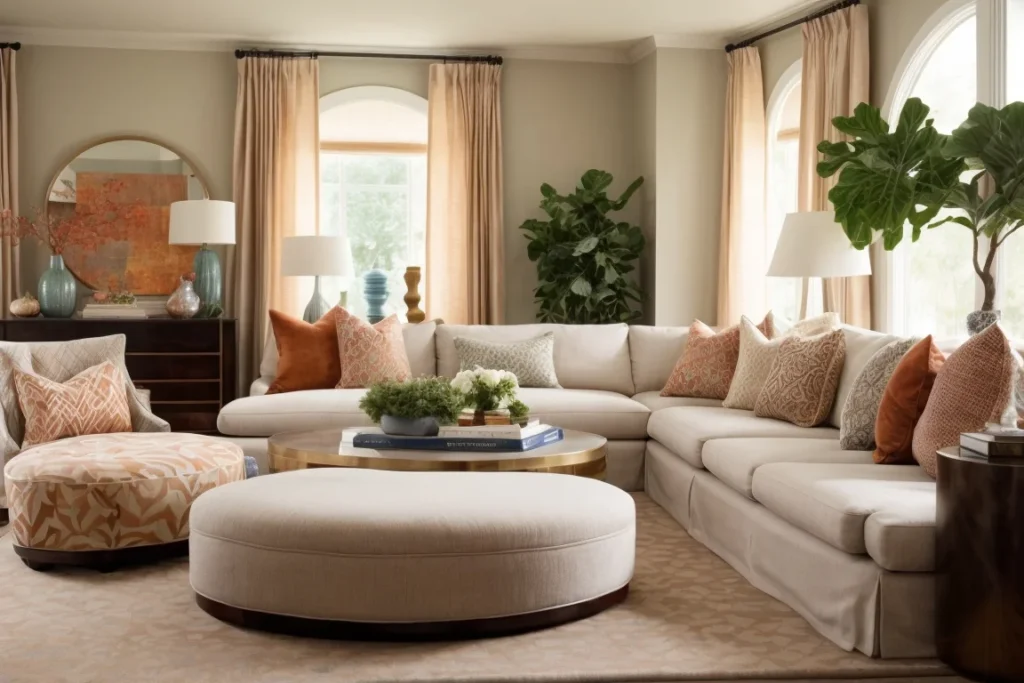
Layer area rugs strategically beneath key furniture groupings to delineate zones visually. Coordinate carpet sizes and maintain consistent color palettes for cohesion. But vary patterns and pile heights to define each space uniquely. The rugs establish purposeful vignettes without compartmentalization.
Some tips for coordinating rugs include:
- Repeating a neutral palette like navy blue in all carpets
- Floating varied patterns like stripes, solids and motifs
- Mixing materials like flatweave wool with plush wool styles
The thoughtful rug pairings lend organization while maintaining an expansive, airy interior. The layers define spaces subtly.
Arrange Furniture Back-to-Back Between Areas
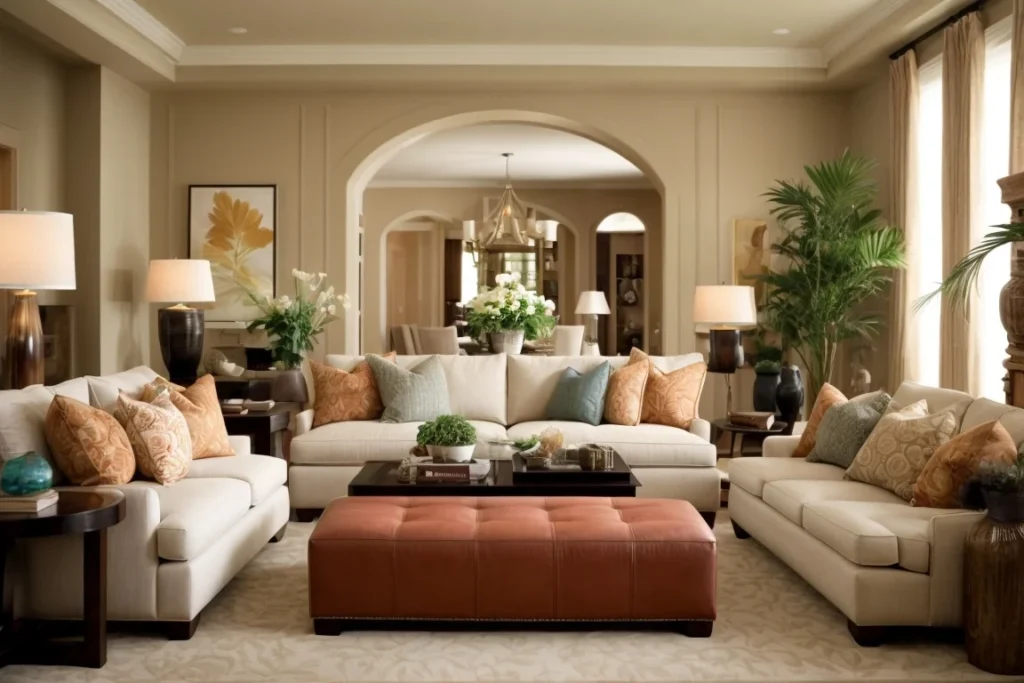
Make smart use of furniture placement to create barriers and boundaries between living room zones. Arrange seating ensembles back-to-back to utilize the center of the room. Angle the two arrangements inward for intimate conversation nooks that also unite areas.
Some examples include:
- Placing sofa backs against the rug edge of an adjacent seating cluster
- Forming an open room divider with back-to-back shelving units
- Floating backless benches perpendicular to define circulation paths
The furniture forms a physical and visual separator between activity areas for a more functional layout.
Add Mirrors and Artwork for Horizontal Divisions
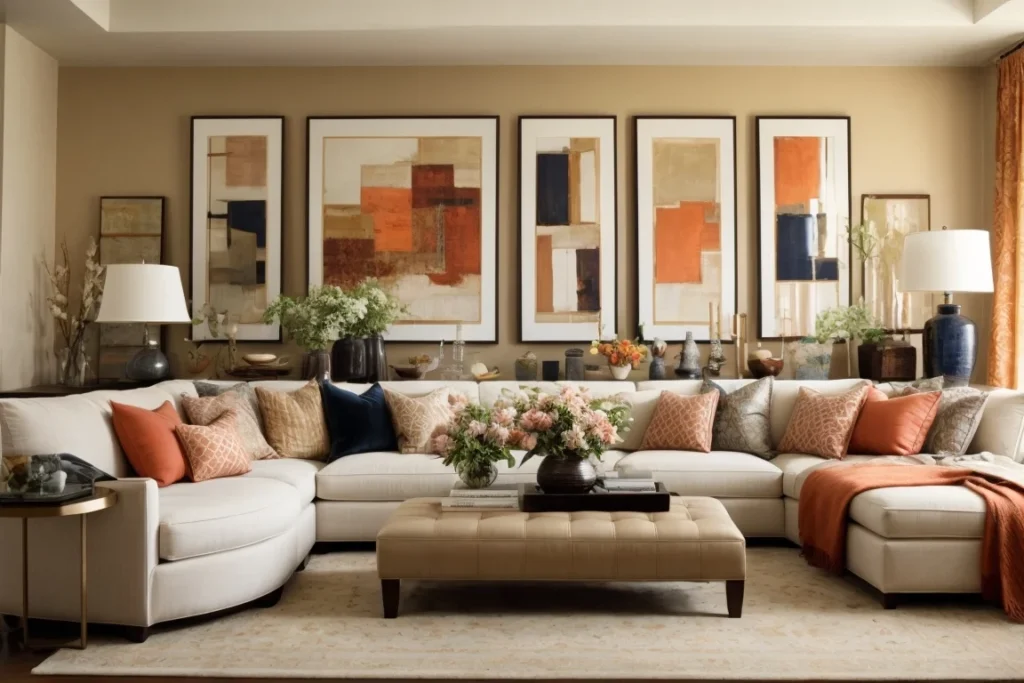
Prevent cavernous walls from looking vacant by installing artwork, mirrors or paneling. Break up large expanses horizontally to establish visual tiers. Position pieces staggered vertically so the wall appears layered. Include varied sizes and frames for eclectic interest.
Some tips for adding horizontal artwork include:
- Staggering a gallery wall with a mix of frame sizes
- Extending artwork onto adjacent walls for a wraparound effect
- Flanking a central mirror with matching canvases
- Creating defined rows, working from large scale pieces down
The art and mirrors lend visual rhythm while preventing vacant voids. The eye flows floor to ceiling effortlessly.
Incorporate Pendant Lights Over Each Vignette

Make living room seating arrangements feel intimate and defined using overhead pendant lights. Tailor the pendant size and suspension height to each vignette’s footprint. For example, hang a linear fixture over a sofa while a bubble lamp illuminates armchairs. The fixtures define each zone.
Some pendant light tips:
- Repeating matching pendant styles over identical seating
- Cascading bubble lamps descending in size across a room
- Marking conversation nooks with drum-shaped pendants
- Defining circulation paths with adjustable height pendants
The strategic mix of pendant lighting lends visual continuity while differentiating room sections simultaneously.
Thoughtfully dividing a capacious living room lends sensible organization, architectural rhythm and intimate appeal. Strategic furniture placement, area rugs and lighting details design specialized zones that feel cohesive yet unique. The overall aesthetic remains spacious, breezy and connected while activity areas gain purposeful definition.
Large Family Room Ideas
For households with multiple generations or kids, a spacious living room easily transforms into a casual, inviting family room. Include versatile furnishings and activity zones tailored to family pastimes. Make media viewing, gaming and lounging equally enticing and comfortable. The family-friendly layout encourages both shared and individual enjoyment.
Include Modular Seating for Fluid Arrangements
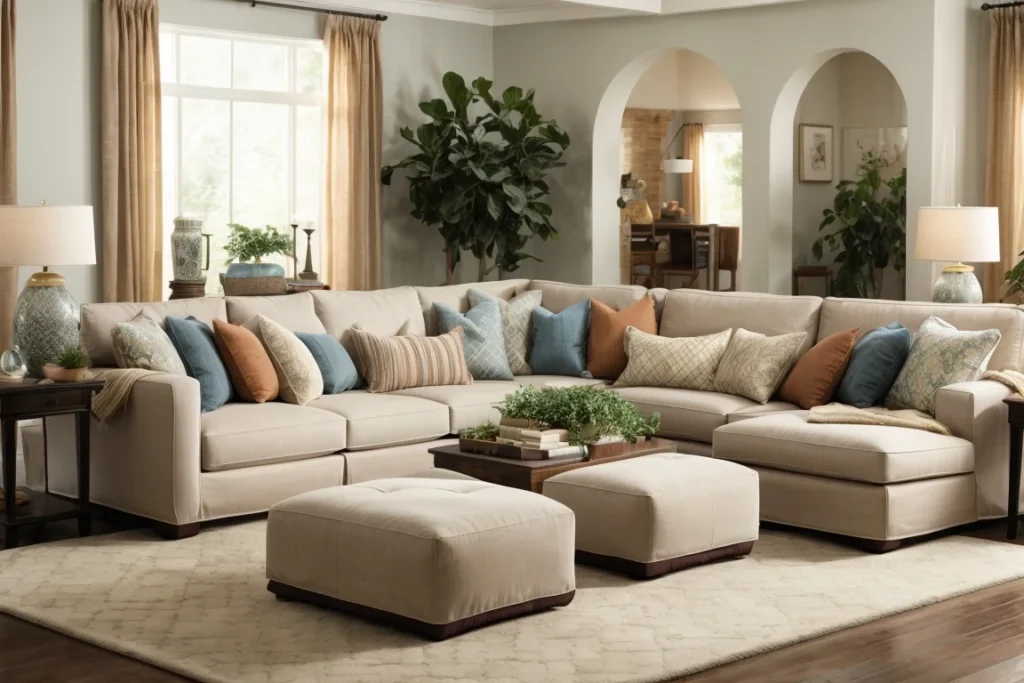
With active families, flexible seating proves more functional than stiff arrangements. Modular pieces allow quick reorganization as needs change. Sectionals, ottomans and slipcovered sofas withstand everyday use. Arrange seating in an L-shape for both conversation and TV viewing.
Some family-friendly modular seating options include:
- U-shaped sectionals wrapping around a central table
- Square ottomans that tuck beneath coffee tables
- Deep slipcovered sofas with washable covers
- Convertible sleep sofas for accommodating overnight guests
- Storage benches and cube stools to stack away when not in use
The mix-and-match furnishings adapt to changing needs and endless activities. Sturdy yet movable pieces suit family spaces best.
Designate Space for Gaming and Crafting
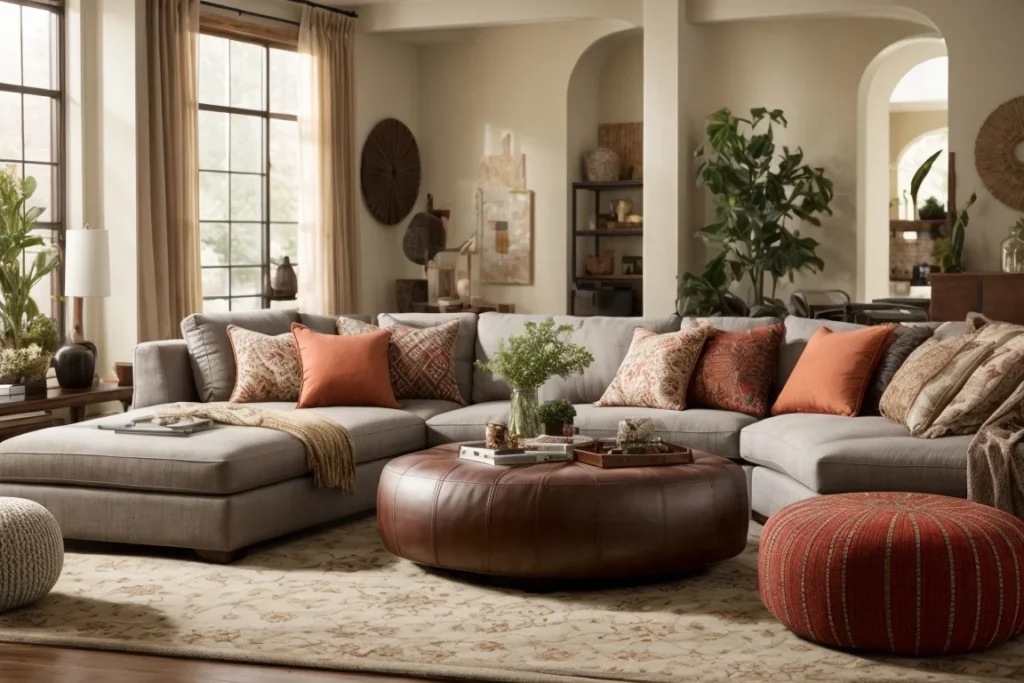
For households with kids and teens, carve out areas for gaming, crafting and homework adjacent to the living room seating. Look for multifunctional furnishings like storage ottomans that can serve as extra tables. Float a large area rug to define the zone visually. The dedicated space keeps favorite activities close yet defined.
Some tips for adding hobby zones include:
- Nesting hobby tables and stools beside living room seating
- Floating large storage ottomans that act as surfaces
- Mounting wall-mounted drop-down desks discreetly
- Extending a vibrant patterned area rug underneath
- Floating open shelving above for quick supply access
The informal activity hub adds lively spirit within the family living space.
Add a Casual Dining Area

For family-style meals and snack times, include a casual dining nook tucked away from the living area. Opt for a rectangular table that seats six comfortably. Look for wipeable, stain-resistant chairs and tabletops for arts, crafts and meals. Use an area rug to define the footprint.
Some casual dining tips:
- Choosing a durable wood table on sleek metal legs
- Adding armless parsons chairs that tuck in neatly
- Floating open shelving nearby for dishware storage
- Extending a braided rug underneath the table and chairs
- Including a floor lamp over the table for ambient light
The informal dining spot allows quick family meals without disrupting the living room layout.
Include Media Seating Facing the Television
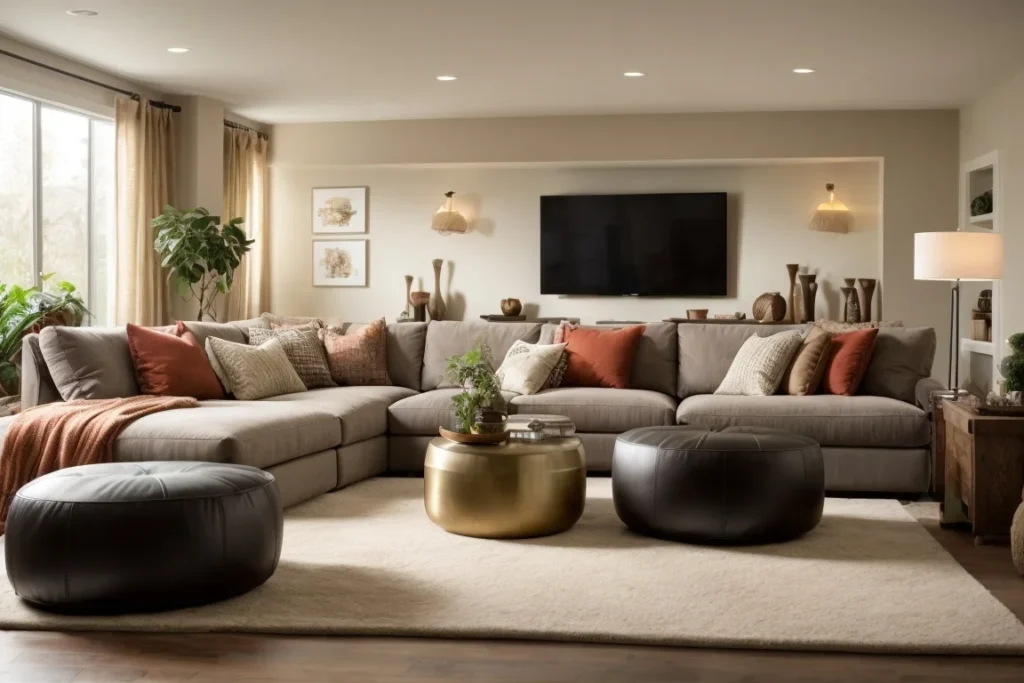
For optimal family movie nights and gaming sessions, angle sofa seating directly facing the wall-mounted television. Float plush armchairs adjacent to create a cozy viewing room. Include sturdy ottomans to kick up feet during screen time. The media zone doubles as a hangout space.
Some ways to define the family media area:
- Floating comfy recliners and deep sofas aimed at the TV
- Tucking sturdy ottomans between chairs for footrests
- Layering side tables throughout for convenient snacking
- Adding a sleek media stand below the wall-mounted television
- Extending the area rug to include media furnishings
The defined yet casual setup transforms movie time into a treasured family ritual.
Large Living Room Furniture
Filling substantial living room square footage requires appropriately scaled furniture with ample presence. Oversized silhouettes make interior volume feel well utilized rather than empty. Seek out long, low profiles and expansive footprints. Yet balance sturdy frames with lightweight complements to maintain an airy, spacious aesthetic.
Select Statement Sofas with Substantial Profiles
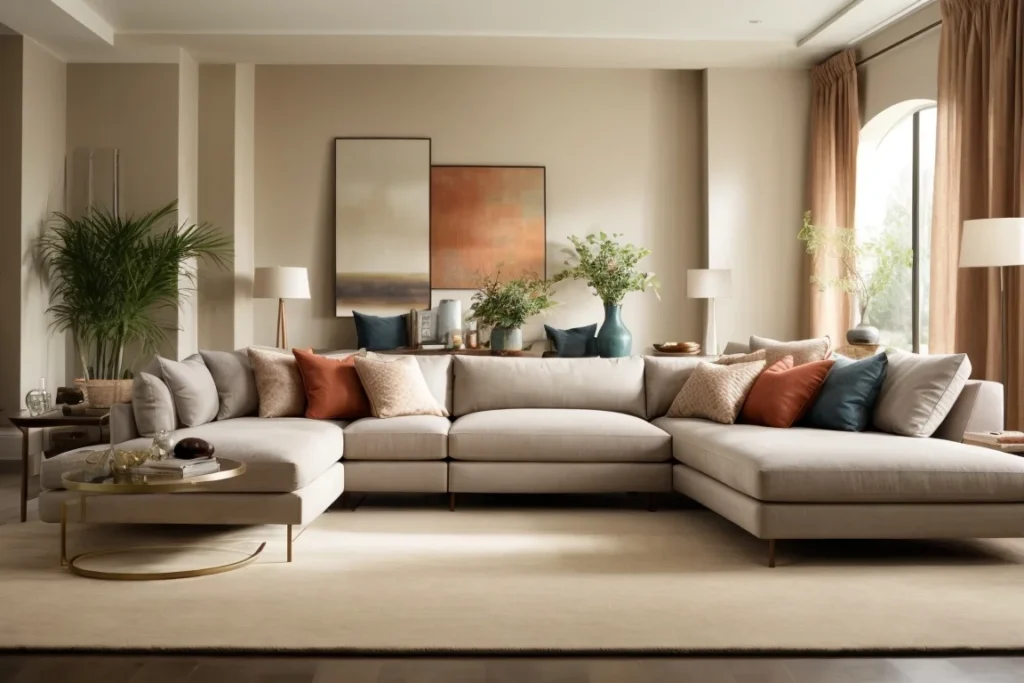
Make the living room layout cohesive by choosing substantial sofas and sectionals in generous proportions. Look for streamlined frames around 104 inches wide and 36 inches deep. Clean, simple lines suit the spacious interior best. Deep, comfortable cushions encourage lounging with minimal exposed base.
Some oversized sofa options include:
- 104-inch linen-clad sectionals with a chaise extension
- Track-arm sofas on a slim, recurring metal base
- Tufted roll-arm sofas with abundant loose cushions
- Deep loveseats around 70 inches wide for facing arrangements
The expansive yet refined seating options anchor the living room layout reliably. Clean lines allow other furnishings to layer naturally around the ample frames.
Incorporate Elegant Benches Along Walls
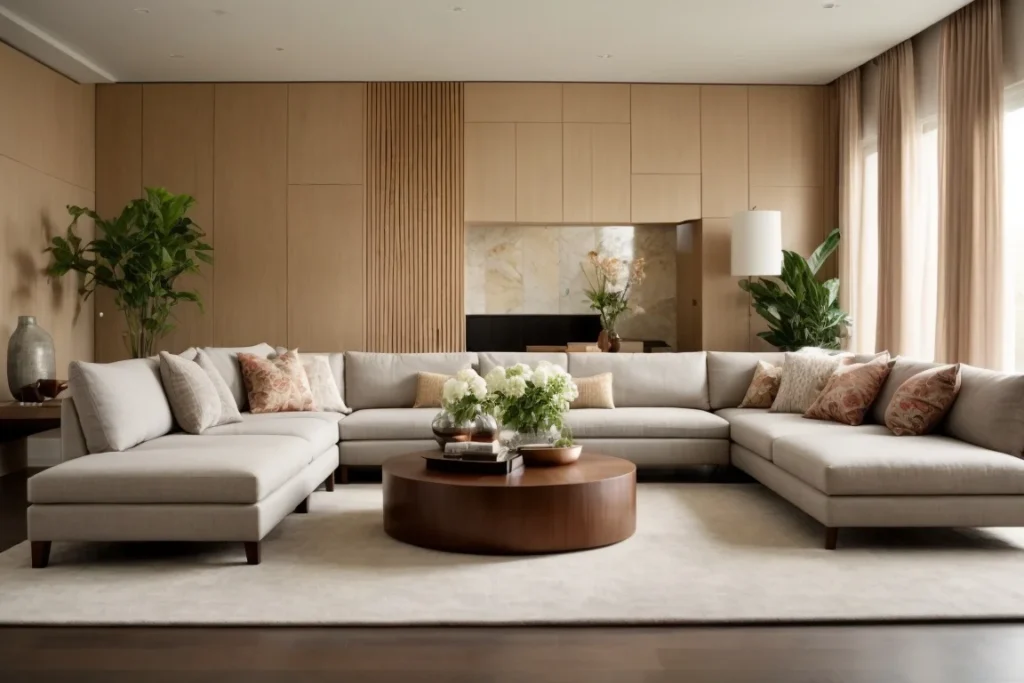
Prevent cavernous perimeter walls from appearing sparse and vacant. Float substantial bench seating horizontally along the walls. Look for 60-84 inch long upholstered benches as part of sectional arrangements or freestanding against walls. The streamlined seats fill space stylishly.
Some ways to incorporate bench seating:
- As the corner piece of a spacious L-shaped sectional
- Back-to-back facing toward the room’s center
- Beneath wide living room windows for ample seating
- Border the perimeter of a spacious sitting room
The linear benches lend both form and function. Their solid profiles beautifully fill void space.
Choose Lightweight Accent Pieces
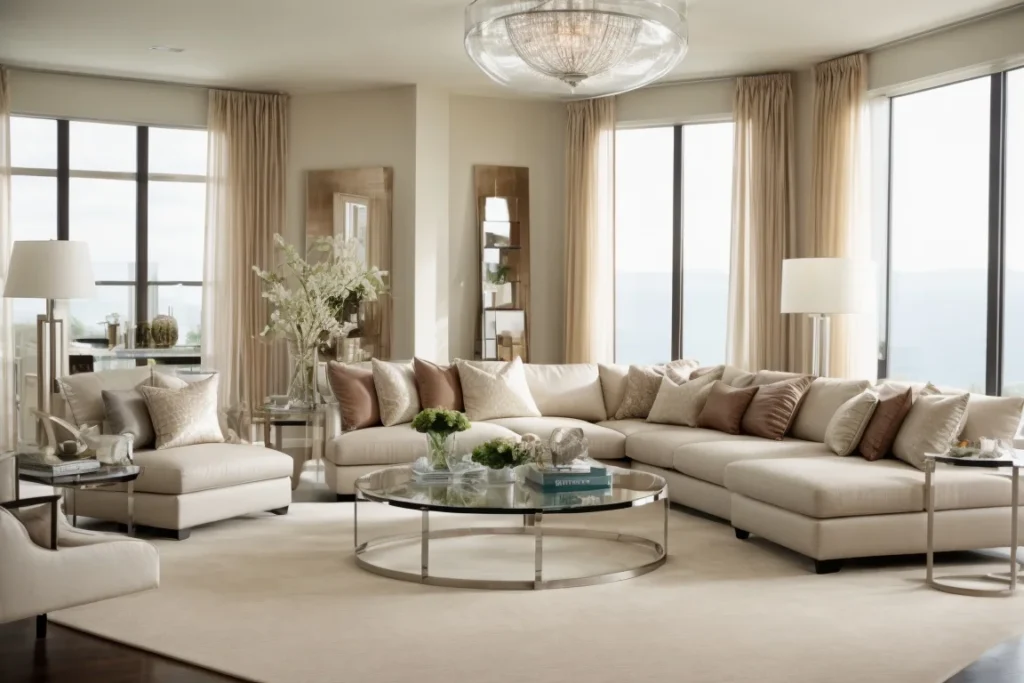
Balance the substantial seating with lightweight complements to maintain an airy, spacious atmosphere. Incorporate glass, acrylic and streamlined metal elements. Their sheer or open profiles contrast the heft below for breezy elegance.
Some airy accents include:
- Clear acrylic dining chairs surrounding tables
- Glass top nested coffee tables with slim metal legs
- Wire side chairs with transparent mesh seats
- Acrylic pedestal lamps with tapered stems
- Mirrored console tables reflecting light beautifully
The transparent profiles add subtle elegance while giving ample breathing room between furnishings. They keep the voluminous interior feeling serene and comfortable.
Add Architectural Built-In Cabinetry
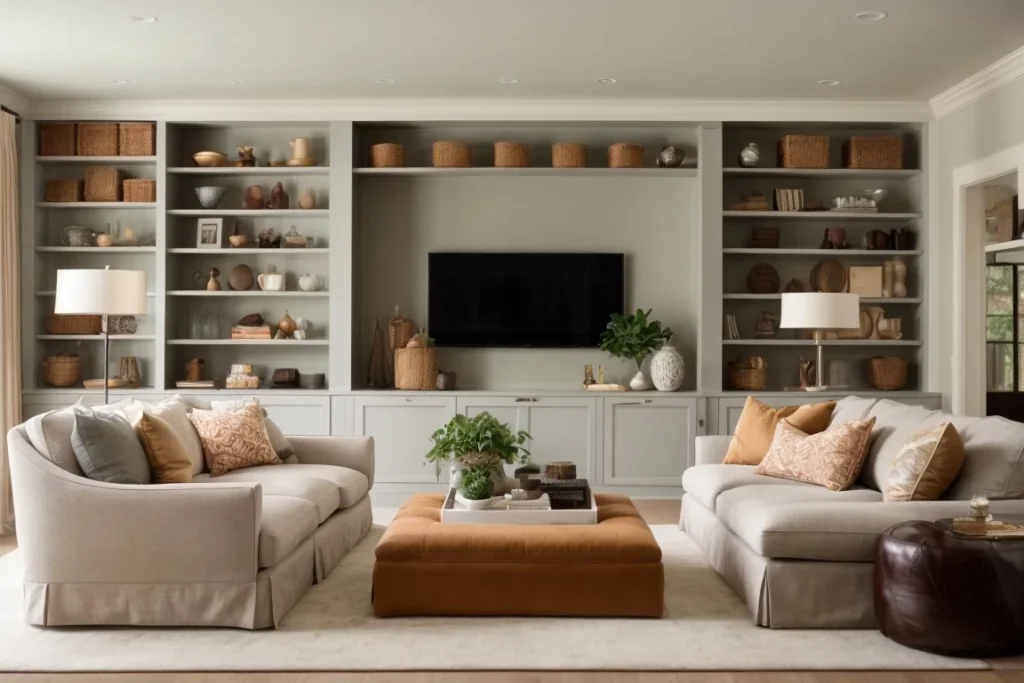
Take advantage of sizable living room wall expanses by incorporating architectural built-in cabinetry. Custom storage pieces lend visual framework and functionality. Opt for units that stretch floor to ceiling to maximize space. Include display shelving interspersed to prevent a bulky, closed-in aesthetic.
Some built-in cabinetry ideas:
- A wall-long combination of open and closed storage
- Window seat bases with roll-top doors and inner drawers
- Sliding ladder racks that access uppermost shelves
- Display nooks topped by crown molding and ambient lighting
The built-in storage options elegantly fill space while providing ample concealed storage. Their architectural forms suit generous proportions beautifully.
The expansive living room deserves special interior design considerations to transform empty square footage into welcoming elegance. Careful space planning, abundant lighting, substantial furnishings and organic texture design an interior with lounge-worthy warmth and style befitting the grand volume. With detail oriented furniture arrangement and scale, a sizeable living room feels serenely spacious rather than cold and hollow.
Final Thoughts
Decorating and designing an oversized living room requires thoughtful spatial planning and furnishings. Divide the cavernous interior into well-defined, functional zones using furniture arrangements, area rugs and lighting design. Incorporate substantial, overscale pieces with airy accents to fill the voluminous space. Add warm, cozy elements like plush textiles, ambient lighting and indoor plants to counterbalance the hard surfaces. The strategies help transform an outsized living room into an inviting, multi-purpose gathering space for the whole family.
